
For this anniversary issue, we consider developments and technologies that have been important throughout nine decades of being modern.
Peter Zelinski | Editor-in-Chief
They say it was the pockets common to machinists’ outfits at the time. The original dimensions of Modern Machine Shop were chosen to allow the machinist of 1928 to carry the magazine either in the side pocket of a shop coat or in the chest pocket common to some machinists’ aprons. While the publication is no longer that small size today (we first changed its dimensions in 2008), many readers of MMS still keep the magazine close at hand and close to their hearts.
They really do. I am biased, of course, but the frequency with which we hear from readers who honor us by describing their appreciation for the publication and its work over the years leaves me persuaded that MMS is more than just an industry trade magazine. The affection and loyalty the magazine has won stem in part, I believe, from the priority this magazine has had from the beginning, the priority that focused on those very pockets in the machinists’ clothes: an aim to belong to this industry. Those of us who produce MMS work for Gardner Business Media, the same family company that began by launching this book. And at the encouragement of owners of this company, we give our primary sense of allegiance to metalworking rather than to our own field of media or publishing. The business philosophy of Gardner and MMS has always been this: Focus on manufacturing—aim simply to be of greater and greater use to manufacturers—and success will come. It has worked so far.
The June 2018 issue marks 90 years of Modern Machine Shop. We wanted to observe the milestone. Enough of us involved with MMS have long-enough tenure that we remember the 75th and 80th anniversaries, which we allowed to pass only lightly considered. We wanted to do better this year, but how? Should we look back at major developments of the magazine?
The problem with that approach is the developments we would be apt to choose—special issues, changes in media, transitions on the editorial team—would seem significant to us, the staff. The MMS reader experiences different milestones with the magazine. They relate to ideas explored and technologies adopted because of what the reader found in its pages. We never get to know which specific magazine issues offer the breakthroughs for our readers because the important discoveries, the right ideas that come at just the right time, are different for every shop. What our readers appreciate about MMS and what they benefit from are its regular issues.
So that is the way to look back. In a special collection of articles in the pages to follow, we look beyond just epochal or event-defining issues of the magazine. Rather, we look back at regular issues of Modern Machine Shop out of the many decades of the magazine’s history. Decade by decade, the magazine has always sought to be relevant and helpful to the metalworking business leaders and professionals of the time. What did that look like, and how does it look to us now? The staff of MMS has spent some time poring through back issues in search of articles that highlight where manufacturing has been, and that might have offered some of those milestones representing advances for shops at the time. Let us share with you what we found.
But first, on behalf of all of us involved with MMS, let me extend my gratitude. Thank you for giving us your attention; thank you for giving us the chance to aid you in your work. Likely there is no machinist’s apron you wear today, but thank you for slipping the magazine into briefcases and carry-on bags. Thank you for passing it through the office and through the shop until its covers tear and its pages become creased. Thank you for 90 great years of getting to be part of this industry.
Now, stay with us a while longer and read on. Here is what was going on in some of those 90 years.

The first issue of Modern Machine Shop from June 1928. The original dimensions of the magazine were chose to fit in the side pocket of a machinist's shop coat or in the chest pocket of a machinist's apron.

Here are faces behind names on our Staff page. The staff of MMS currently includes (back row, left to right) William Caldwell, Jedd Cole, Julia Hider and Matt Danford; (middle row, left to right) Kent Luciano, Eli Plaskett, Peter Zelinski and Travis Egan; (left of logo, clockwise from back) Derek Korn, Stephanie Hendrixson and Rhonda Weaver; (right of logo, back to front) Brent Donaldson, Mark Albert and Emily Probst.
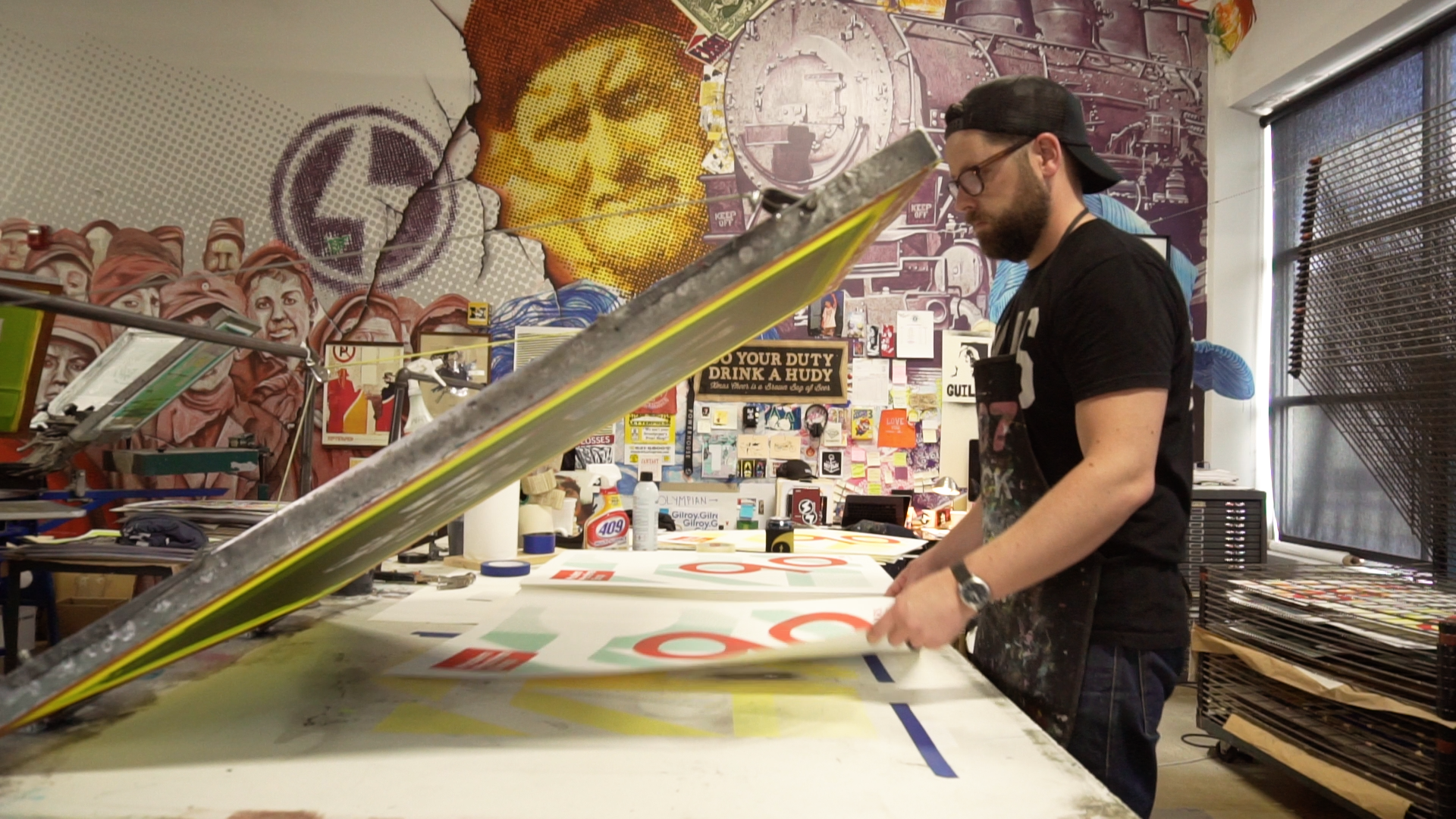
Drawn Together
To celebrate Modern Machine Shop’s 90th anniversary, we commissioned this commemorative poster by Powerhouse Factories, a creative agency best known for its original screen prints for musical artists. Learn more about the agency’s “shop” culture and how the poster was designed and printed in this blog post.
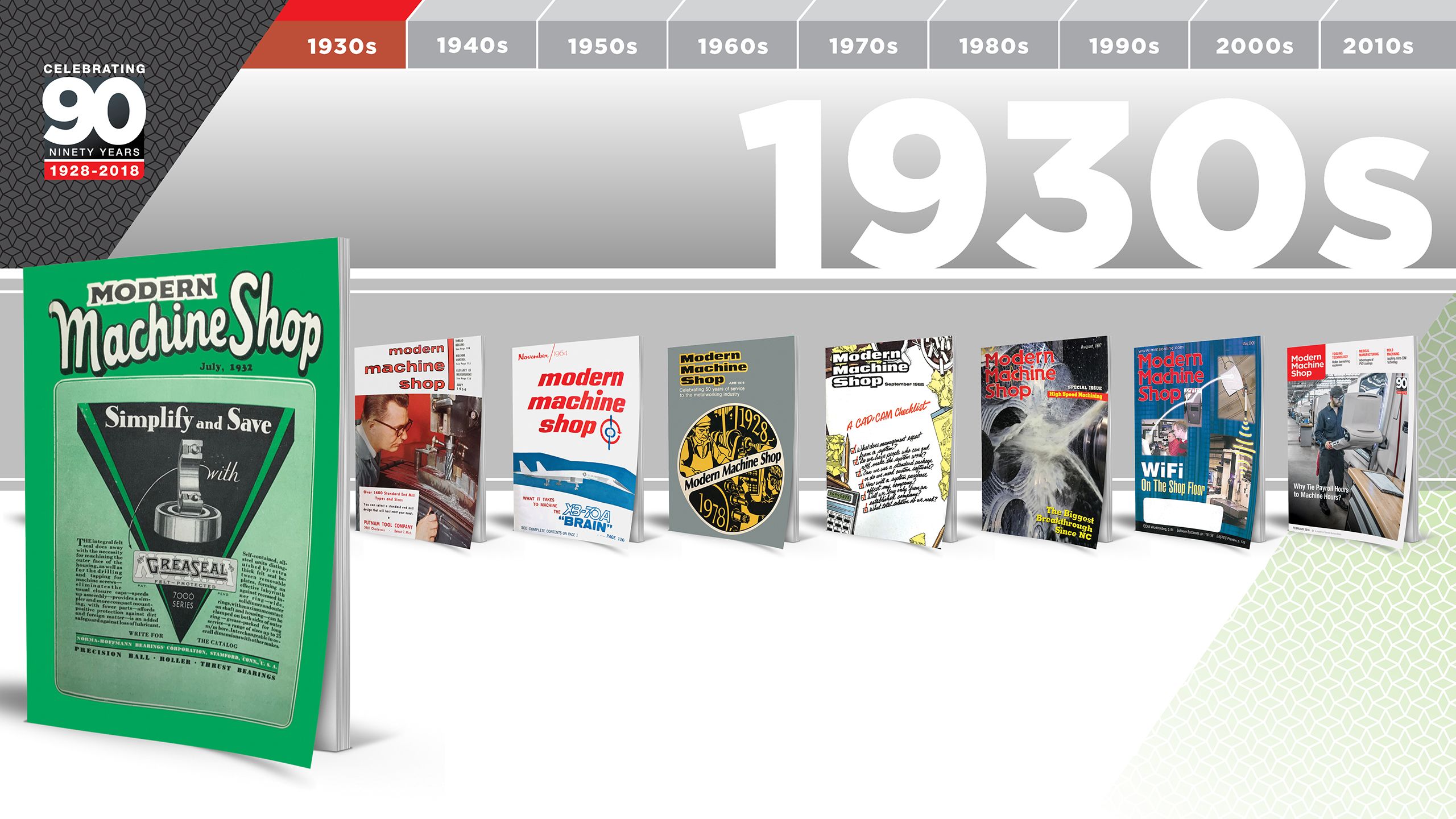
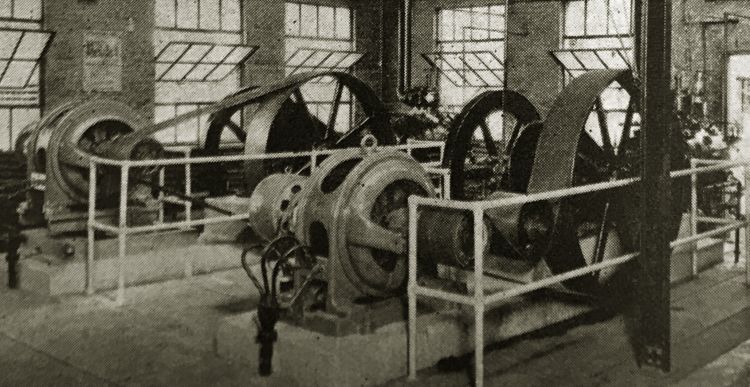
Original caption from the July 1932 issue of Modern Machine Shop magazine: Westinghouse synchronous motors driving 110 h.p. air compressors. The compressor in the foreground is equipped with an idler drive, but the idler is unbalanced and the tension, therefore, is increased instead of decreased. The drive on the compressor next to the window is a Rockwood drive with automatic tension control.
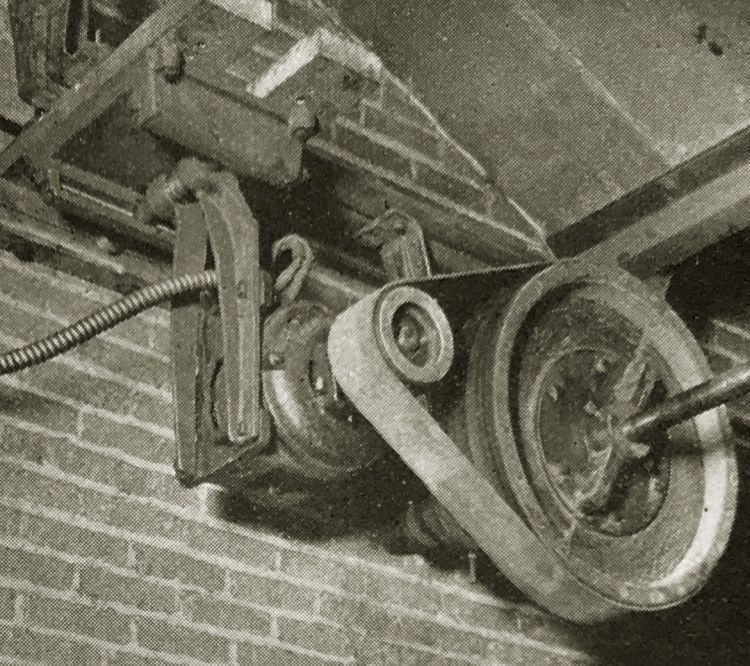
Original caption: Rockwood drive as applied to a lineshaft. As the tendency toward increased lineshaft speed increases, the size of the driven pulley will be reduced. Note the very short center distance--just enough to allow for a clearance of the two pulleys.
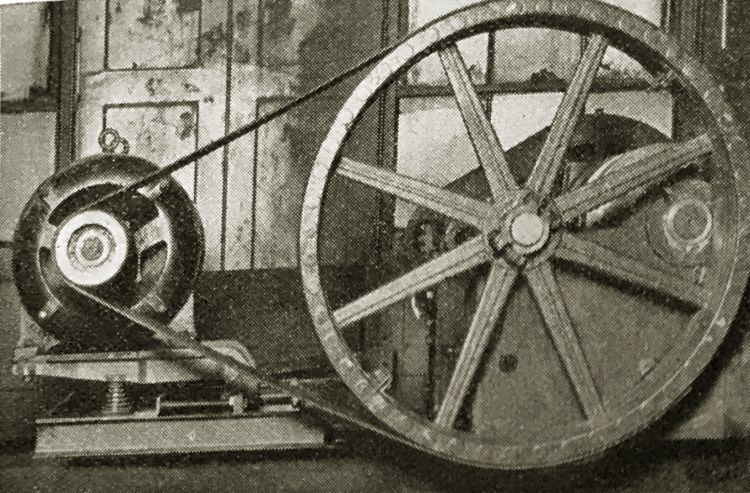
Original caption: The Rockwood drive base lifts the motor off the floor from 5 in. to 10 in. and keeps it away from floor dirt and grit. The importance of perfect control of belt tension is apparent when it is considered that on an air compressor such as this one, the annual power bill equals the first cost of the compressor.
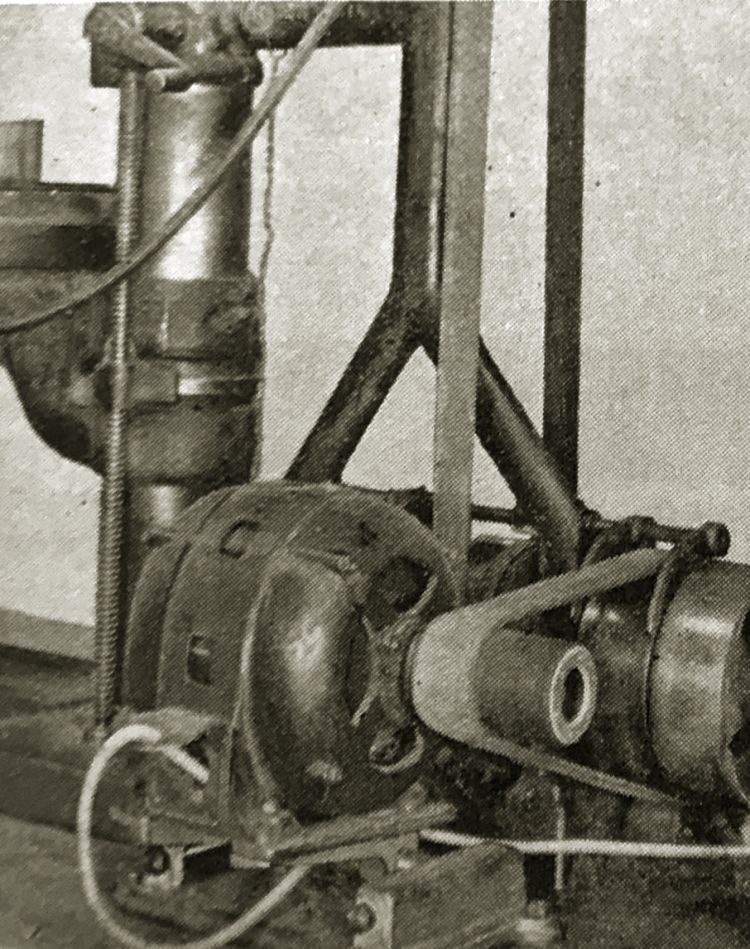
Original caption: Rockwood short center drive applied to a drill press, using a floor mounting that permits the shifting of belts. The center distance is 18 inches.
Machine Shops Take a Belting in the 1930s Depression
Mark Albert | Editorial Director
With business way off because of the Great Depression, shops and plants were pulling back. However, the editor’s column in the July 1932 issue of Modern Machine Shop advised readers to take advantage of the lull to plan and prepare for “the next cycle of prosperity by laying out the steps that can be taken to bring the plant to its highest point of efficiency.” The specific steps he recommended are ones we would recognize today as lean manufacturing practices and refer to as value-stream mapping, cellular manufacturing and 5S. Some things never change.
But other things do. The best way to power machine tools was changing radically, for example. In his column, the editor also called for plans to replace worn-out tools, machine parts, belts, pumps and other equipment.
The belts he was referring to were, in fact, the leather belts that connected a rotating overhead line shaft to the spindle drive on the machine by means of ceiling-mounted pulleys. Machining speed could be controlled roughly by moving the belt from one step to another on a cone-shaped pulley attached to the outer end of the machine’s driveshaft. At the time,these belts represented the primary means of powering most machine tools and production equipment.
So important and prevalent were these leather belts,that the lead article in that issue was devoted to the care and maintenance of belt-driven equipment. The article, part of an extensive three-part series, was authored by the chairman of the Engineering Commission of the American Leather Building Association, along with two professors in machine design from the Massachusetts Institute of Technology, which was then, as now, one of the top technology schools in the country and a leading developer of industrial innovations.
All three articles are a mix of practical dos and don’ts, technical guidelines and explanations of best practices. They are illustrated with tables, diagrams and numerous photos. Clearly, this was a serious topic deserving serious treatment. As the first paragraph in the second article states, “the engineering requirements and the successful use of leather belts are just as rigid and necessary as in any branch of science.”
Eventually, lineshafts and leather belts disappeared as machines powered by electric motors became the norm. Numerous examples of motor-driven machine tools already appeared in the ads running in that issue. However, even into the 1980s, it was not unusual to see a machine shop in a building where the lineshafts were still in place between the joists of the ceiling. The exposed belts, of course, were long gone.
Yet the general issue of power transmission remains a vital concern to builders and users of machine tools in the present. We are still debating the merits of direct-drive versus geared systems. The energy consumed in powering machines and the means to minimize it are now the focus of many “green” initiatives and sustainability programs. Sensors are becoming widely used for detecting and measuring conditions in power-transmission components, so digital signals can be sent to machine-monitoring systems and beyond to the cloud. Power-transmission systems are now some of the most important “things” under the watch of the Industrial Internet of Things.
Likewise, delivering reliable, insightful and expert knowledge remains a vital concern for the editors of Modern Machine Shop. We still strive to zero in on the technology topics our readers will find the most useful, whether it is emerging technology such as machine learning, urgent issues such as cybersecurity, or enduring matters of plant and people management. This is a relentless, unending pursuit because technology and management practices are constantly changing.
Economic conditions also change. The Depression dragged on for years after the July 1932 issue was published. Modern Machine Shop, in fact, would have to skip an issue early the next year for want of adequate advertising revenue (the only time that has occurred inits long history). Not until 1938 did some stability and growth return to the U.S. economy. Then it seemed that the belting most businesses and factories had endured was finally over. However, the world was already headed toward war, and U.S. manufacturing soon would be put to its greatest test in the following decade.
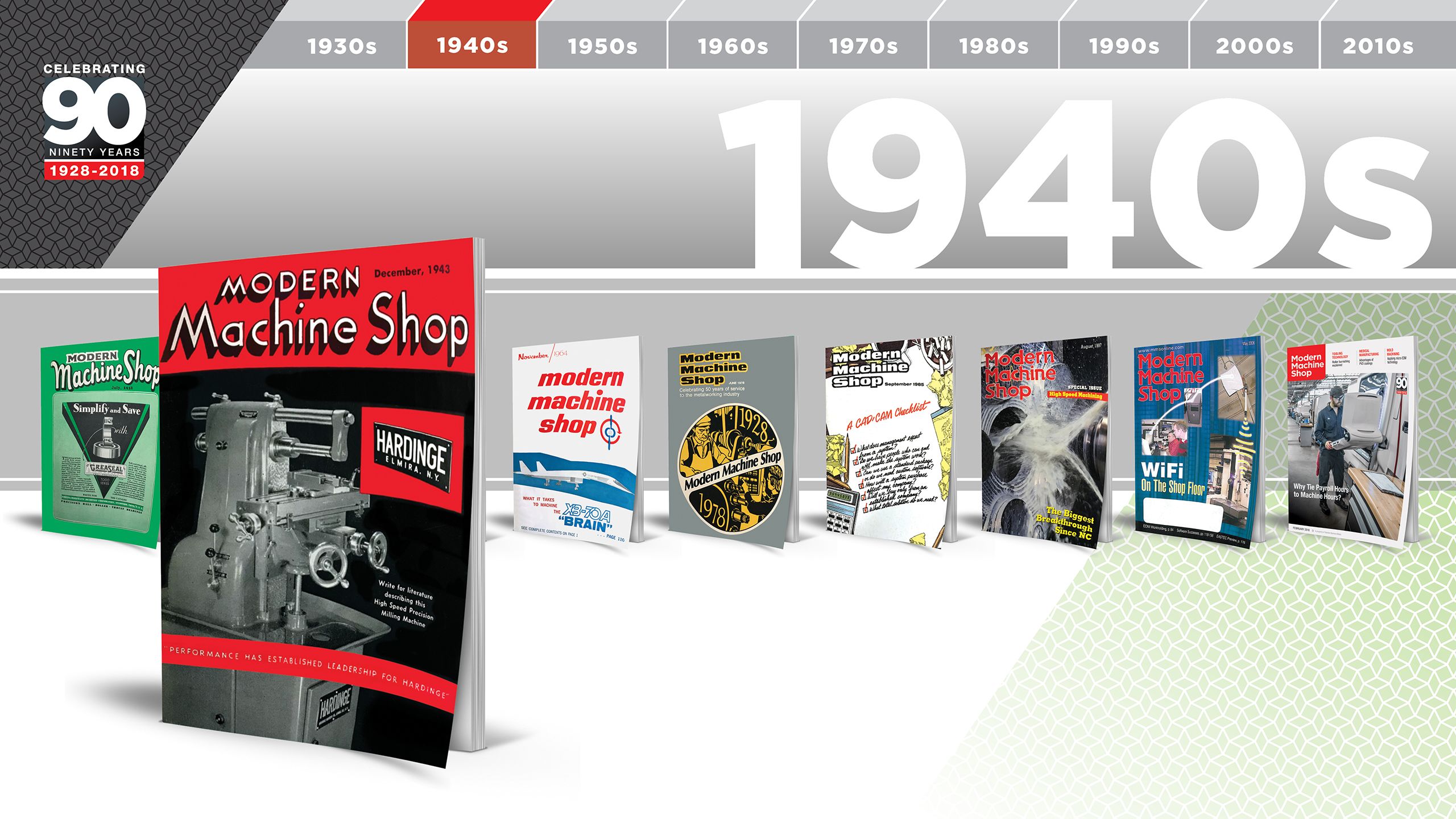
How They Rolled During World War II
Peter Zelinski | Editor-in-Chief
Here is a statement few would contest: U.S. manufacturing capability was vital to the Allied victory in World War II. Judging by the ads and articles in issues of Modern Machine Shop through the early 1940s, that same point was just as apparent while the war raged. Indeed, by 1943, manufacturers were already anticipating the coming victory. An ad from South Bend Lathe Works in that year invited readers to place advance orders for machines that would be manufactured for them just as soon as the needs of the War Department no longer dictated production.
That same year, a nine-page feature article appeared in the pages of MMS that offered a detailed appreciation for—of all things—roller bearings.
The article caught my eye in no small part because the bearing is such a frequently underappreciated component. Even among manufacturers, the bearings allowing for smooth and precise motion of their machines are items rarely considered unless one fails. Yet the editors of Modern Machine Shop in 1943, and presumably the readers then as well, could easily recognize the significance of roller bearings as a component of the vehicles and weaponry our forces were using to fight overseas. Nine pages about how Timken roller bearings are manufactured was apparently exactly the right piece for the time.
Seventy-five years later, I turned to Timken again in the spirit of the same appreciation. I showed the article to representatives of the company involved with bearing manufacturing and asked them what has changed.
The importance of the product has not. Today, the company provides mechanical power transmission products along with various bearing types, yet the tapered roller bearings in the World War II-era article remain an easily recognizable item today, still accounting for a large share of the company’s business. Not surprisingly, however, practically every detail of the manufacturing process has changed, and Stephen Johnson says the differences started with the steel.
Dr. Johnson is the bearing maker’s head of R&D and a 43-year veteran of the company. He says the post-war period began what in retrospect seems to him to have been the “gravy years” for the company’s sales. Long-lasting bearings were difficult to manufacture then, and Timken’s expertise gave it far less competition than it faces today. The end of that period came in the late 1970s, he says, because of a development Timken itself helped to realize. Advances in steel processing—specifically, cleaner steel via air melting as opposed to expensive vacuum melting—resulted in high-performing steel at a previously unachievable low cost. By beginning with better steel, it became less difficult to make long-lasting bearings. Suddenly, Timken faced competition from companies that previously would not have been able to challenge it.
Throughout the decades since then, the response that has kept Timken successful has been roughly the same as that of other manufacturers affected by disruptive technologies or market changes. That is, Timken has continually sought to win savings from more efficient manufacturing and to improve its product features to serve higher-value markets.
The steel-making business and the bearing-making business were split into separate entities in 2014, TimkenSteel and The Timken Company. Dr. Johnson belongs to the latter. He shared the 1943 article with several colleagues who commented on various ways manufacturing has advanced. Comparing the processes then and now, here is what they see:
- Inventory. Praveen Pauskar, group leader and technologist for Timken, notes that large inventories of finished goods or work-in-process were apparently taken for granted back then, but now they are recognized as significant sources of cost. This recognition has influenced the choice of part-making operations, he says. The article shows that his company’s process 75 years ago involved races for small bearings made from steel tube cut on automatic screw machines. “The screw machines were great for volume but not flexibility,” he says. Today, the company makes races of many sizes through a combination of quick-change-over forging and milling on CNC machining centers, the combination of which enables economical, just-in-time adaptation to changing order demands without a large glut of parts moving through processing.
- Surfaces. “I don’t see any reference [in the article] to Superfinishing,” says Rahul Chaudhari, manufacturing and metrology manager. From this, he guesses that the process was not part of production then. It is essential today. Superfinishing, in which a fine-grit abrasive is used to produce a smooth surface with a crosshatch pattern instead of grinding’s parallel lines, enables Timken to realize the surface tolerances now required. At a basic level, he says, “the grinding processes are much the same as they appeared to be 75 years ago.” They are now simply more automated, more productive and computer-controlled. Grinding today generally reaches 16 to 20 microinches roughness average (Ra), which is frequently insufficient. Superfinishing brings the surface to better than 5 microinches Ra. This manufacturing advance has permitted the product line’s advance, because a smoother surface means less loss due to friction, allowing a given amount of power to be driven through a smaller bearing volume, as well as greater durability for the bearings.
- Inspection. Bob Wolfe, who is group leader for nondestructive evaluation (NDE), points to the lack of this practice as the omission that seems glaring to him. An example of NDE used today is vision systems, or cameras for detecting defects and other nonconformances. “Back then, I think they would have had a lot of people at benches manually inspecting,” he says. (In other words, they did use vision inspection, just a very different kind.) That benchwork would have demanded quality assurance through auditing samples, he notes, since manually inspecting every piece would have been labor-prohibitive. “Today our customers often expect 100-percent inspection,” he says. More is known now about the limitations of auditing. “Some nonconformances are sufficiently random that catching them through auditing amounts to just luck.”
- Gaging. Larry Keller, metrology and gaging technologist, recognizes a great deal that has improved in the area of gaging—for example, the reliance then on dial indicators providing 0.0005-inch resolution at best. Today, digital sensors offer resolution 100 times narrower. “Back then, we would have used ‘blue’ to visually evaluate form, whereas now we can measure the form precisely,” he says.
- The most notable part of the 1943 article for Mr. Keller might have been its very last sentence, which refers to “a profilograph capable of measuring surface irregularities to within one millionth of an inch.” “I would like to see that gage!” he says in amusement.
The writer of the piece got this detail wrong. Has MMS’s capability in reporting improved to the same extent that Timken’s manufacturing has? I will make a confession: We still get details wrong sometimes. In the case of my colleague from 75 years ago, I cut him a lot of slack. There was a war to fight, after all. And given that it was a war relying on manufacturing, he was doing his part.
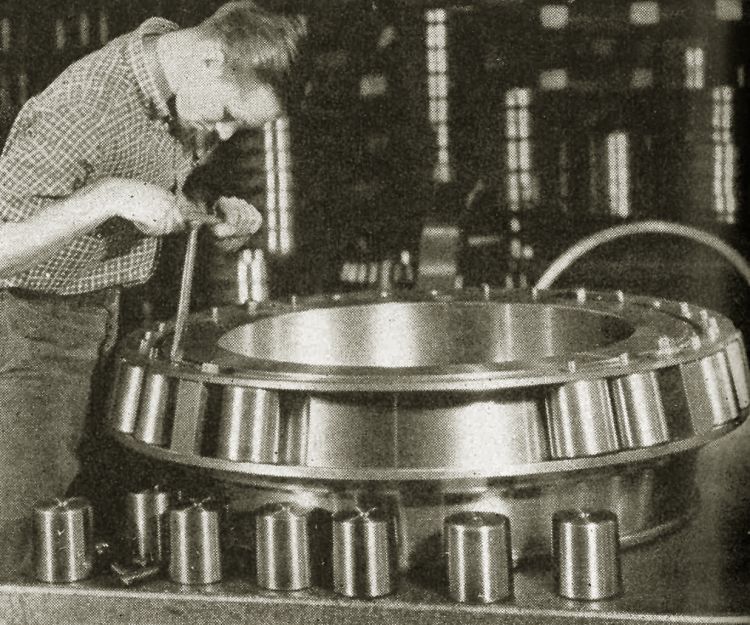
Bearing assembly in 1943. The original caption stated, “Assembly of parts must be done with extreme care or hundreds of hours of labor may be lost.”
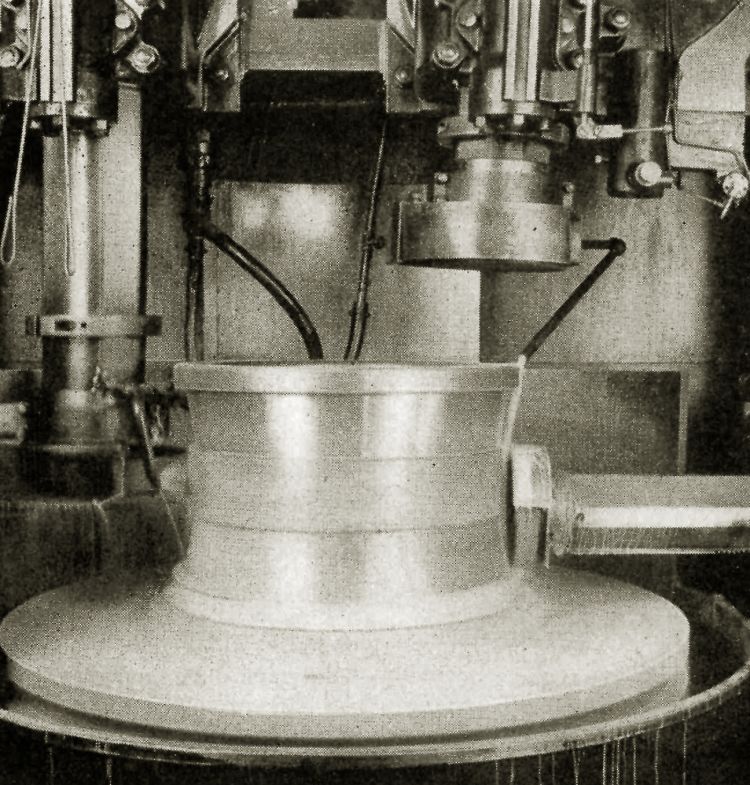
The original caption for this image said, “This grinding machine is producing a mirror-like surface on a special double-tapered roller bearing cone.”
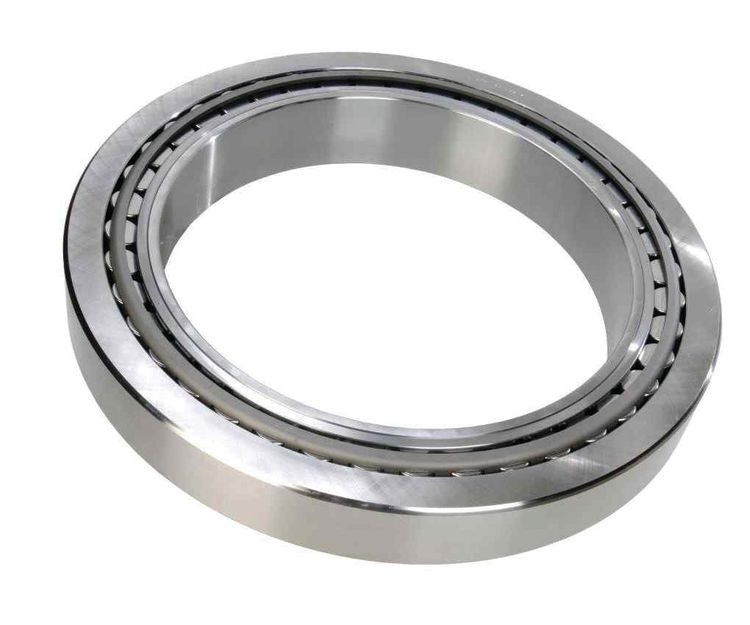
A similar product today. Timken’s product line has expanded, but roller bearings remain a core item
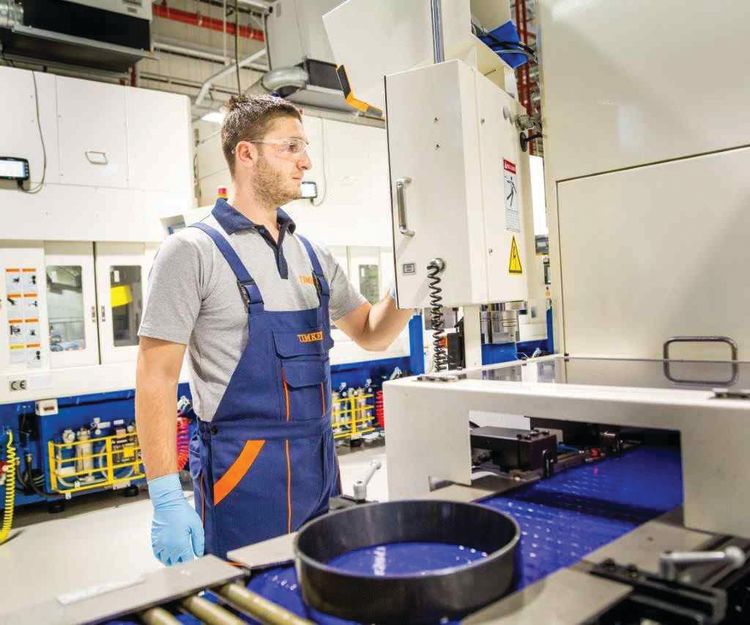
A Timken employee oversees a grinding operation at the company’s modern tapered roller bearing plant in Prahova, Romania.
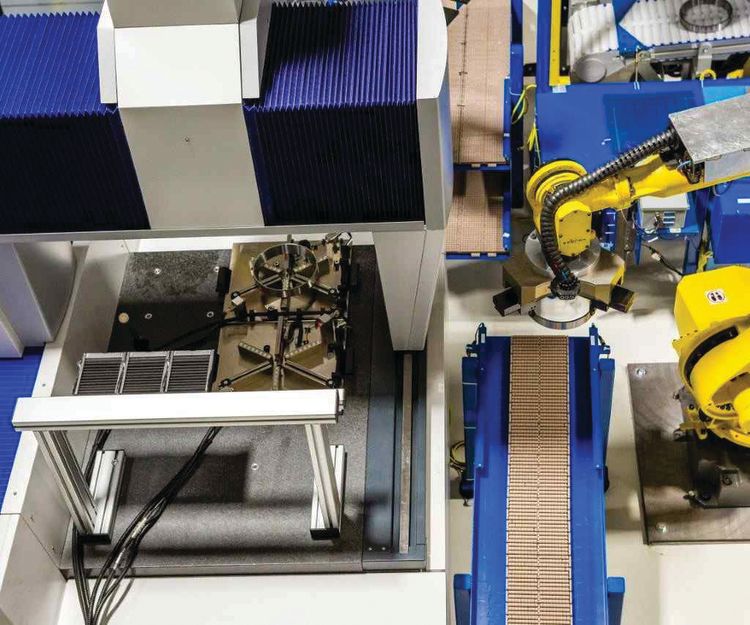
The sophistication and comprehensiveness of inspection is perhaps the most striking aspect of manufacturing process change between then and now. In Romania, a CMM is loaded as part of a 100-percent inspection system for bearings’ critical features.
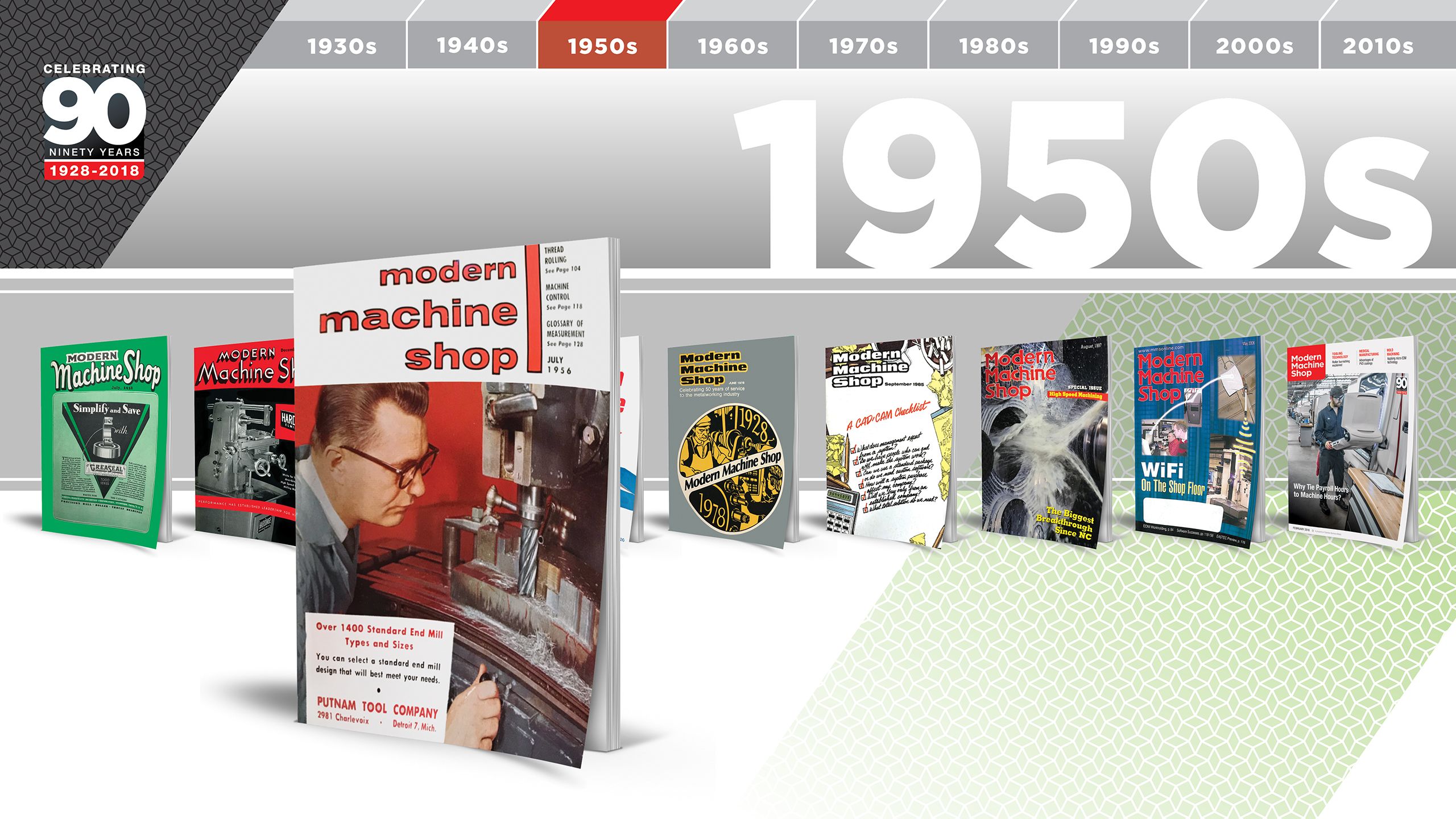
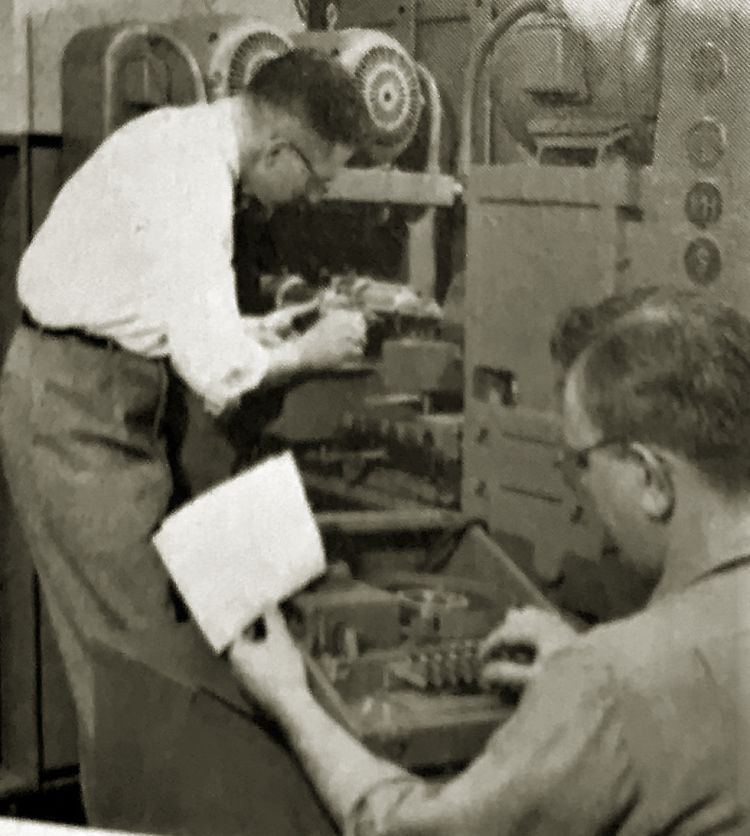
Original caption from the May 1955 issue of Modern Machine Shop: This illustration shows an overall view of the tape-controlled automatic boring machine. In the foreground, an operator uses a perforating machine similar to a typewriter, to punch hole coordinates and feed instructions on the tape.
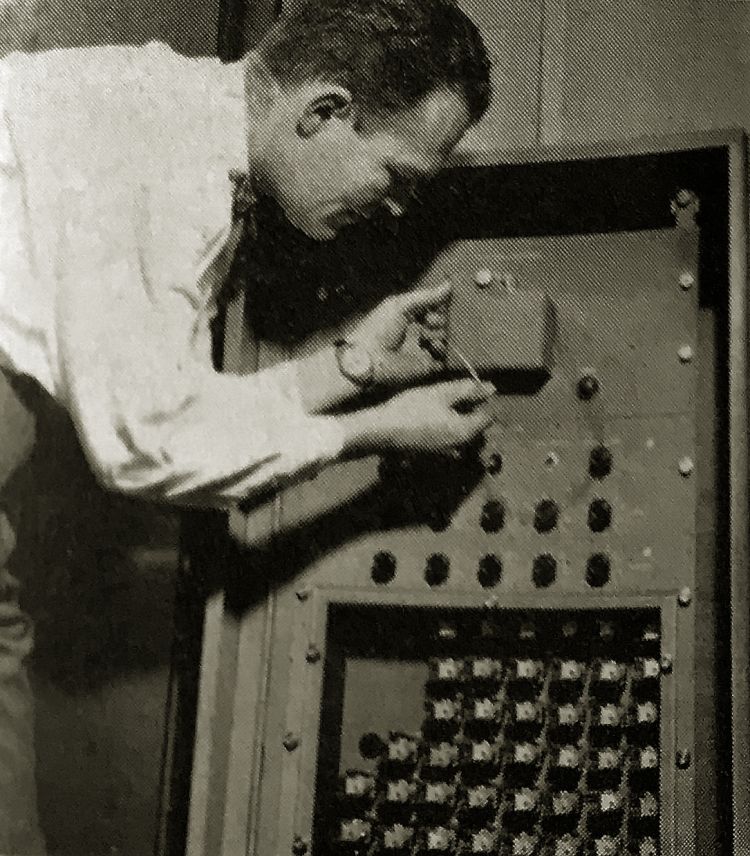
Original caption: Operating instructions are punched on a tape and feed through the "reader" housed in the specially-built control cabinet. Electronic signals from the tape, shown being inserted in the "reader," regulate boring machine operation.
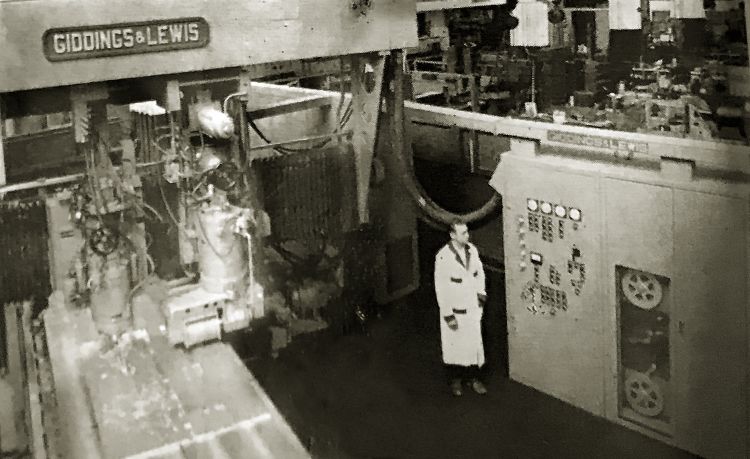
Original caption from the August 1955 issue of Modern Machine Shop: "Plunge," "channel" and "pocket" milling cuts are performed by means of this spar and skin milling machine under complete control of a numerically-prepared magnetic program tape.
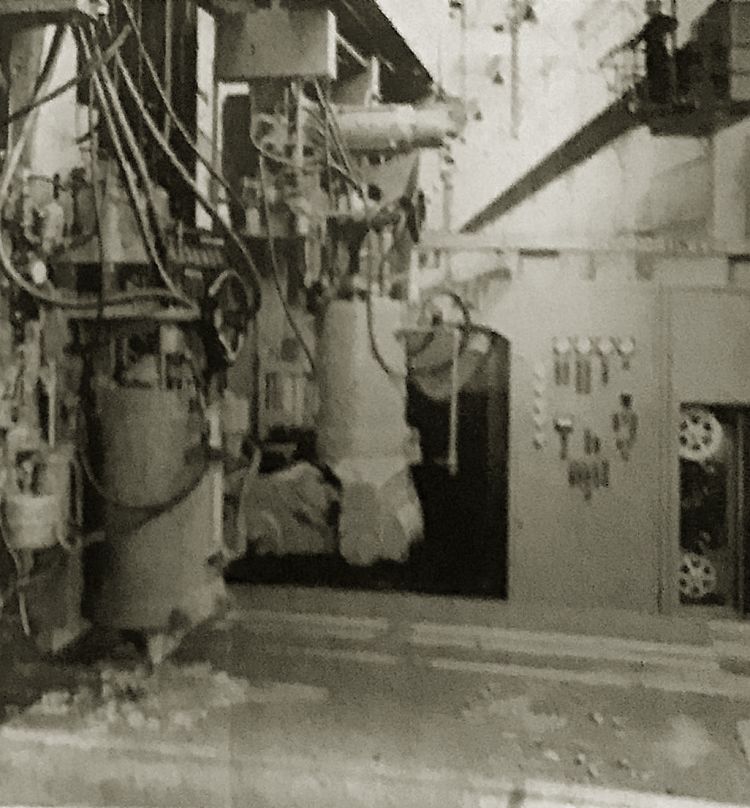
This image from the August 1955 issue of Modern Machine Shop shows a close-up view of a spar and skin miller being operated by Giddings & Lewis Machine Tool Company's Numericord system at its Fond du Lac, Wisconsin plant.
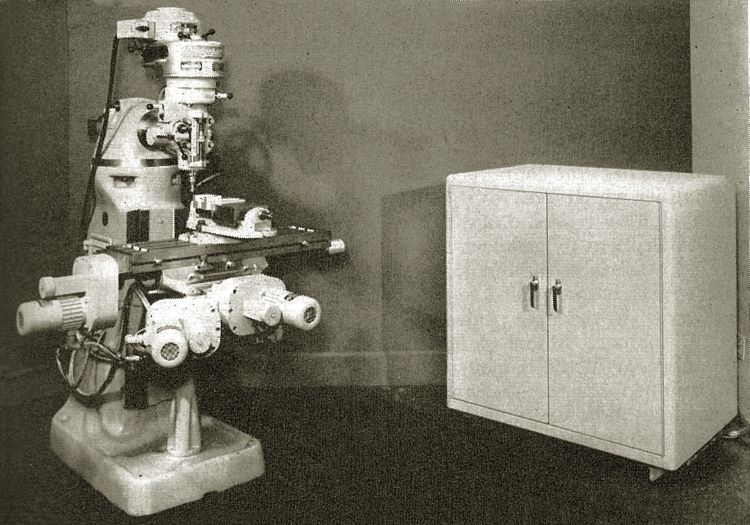
This image from the July 1956 issue of Modern Machine Shop shows a milling machine that is operated automatically via numerical instructions on magnetic tape, which is read by the electrical control unit on the right.
Dawn of Automated Machining
Derek Korn | Executive Editor
Modern Machine Shop published just hints of numerical control (NC) prior to the July 1956 issue.
For example, the May 1955 issue contains a two-page article titled “Tape-Controlled Boring,” which appears to be the first time the magazine published an article about automated machining as an alternative to manual machining. The brief article presents an application of the “punched-tape principle” of automatic machine operation, describing “a standard four-spindle Ex-Cell-O precision boring machine modified with built-in electronic controls and circuitry and a tape ‘reader’ housed in a specially built control cabinet.” One indication that the potential impact of this type of technology perhaps was not appreciated or apparent at that early time was that this article was not promoted on the May cover as other articles were.
Similarly, that article was followed by another in August 1955 titled “Tape Automated Machining,” which describes Giddings and Lewis’ “Numericord” technology that used punched magnetic tape to automatically drive machine movements. This story provides more detail about the concept, describing how the system would use a device called a “director” to convert paper to magnetic tape that would be read by the machine control. Still, NC was not mentioned.
The July 1956 issue seems to contain the first specific mention of NC in a feature article (although the words “numerical control” are used only in a photo caption, not in the body of the article). As shown above, this article was cited on the cover that month, however, it was simply referred to as “Machine Control.”
The article is titled “Automatically Controlling Machine Operations,” and its subhead sums up the promise of this new technology.
“A control tape produced on a planning desk in one city could be duplicated by telephone anywhere in the world, placed in a machine control unit, and production of the part immediately started.”
The automated machine control technology was developed by Electronic Control Systems, a subsidiary of General Dynamics Corp., and dubbed “Digimatic.” The article seems to be based on information gleaned at a public demonstration of its “push-button factory control system” capabilities. It explains that the system was not just well-suited for large operations, but also would be appropriate for small- and medium-size shops. The idea was that Digimatic capability could be added initially to only one machine to enable shops to “approach automation cautiously and well within the limitations of their budget,” as the article explains.
The Digimatic used a “planning desk” with decimal computer and tape recorder to create the magnetic tape that was read by a control unit attached to a modified milling machine. A control unit would sufficiently amplify the electrical impulses recorded on the tape to operate the three servomotors added to the machine to enable automated control of the machine’s X, Y and Z axes.
This magnetic-tape method was one of a few different approaches to NC developed at that time. Ultimately, the industry settled on the punched-tape method. Regardless, machining parts without an operator manipulating handwheels had to be an “out-there” concept at the time. It is not surprising that the writer of one of the first articles about automatic machining referred to this new capability as both “mysterious and startling.” As it turns out, NC was one of the first major steps toward applying automation in a machine shop.
So, is this the most transformative machining process in more than 60 years? The natural transition from NC to computer numerical control (CNC) was certainly impactful, but it was simply an evolutionary step thanks to advancements in digital computer technology. When electrical discharge machining (EDM) arrived on the scene in the late 1970s, some said that it would eventually replace conventional chip-making processes. That never happened. Today, some similarly say that additive manufacturing (AM) could possibly be a huge game changer in terms of discrete-parts production. Thus far, however, AM seems to be more of a complementary technology to CNC machining, not a replacement.
John T. Parsons is considered the “father of NC” thanks to his early work to develop punched-tape automatic machining in the 1940s. It is unknown when the next concept that will be as impactful as NC will be created. However, plan for Modern Machine Shop to be around to present it to our audience.
Industrial Breakthrough
This 1958 video from Hughes Products' Industrial Systems Division describes how early NC technology works.
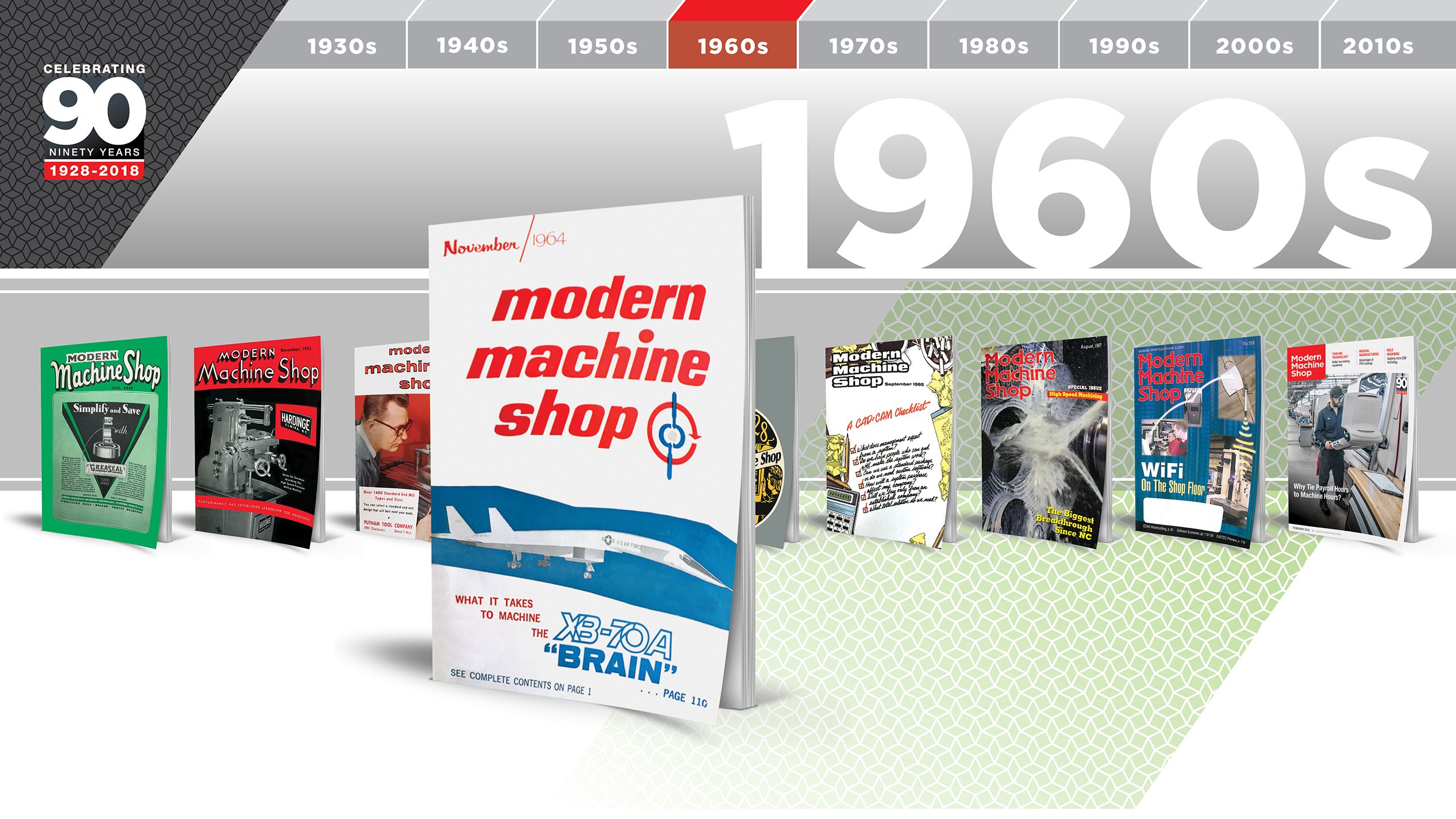
The Radical Becomes Practical in the 1960s
Matt Danford | Senior Editor
Known mostly for sweeping cultural and political change, the 1960s also were shaped by machining technology. Pastel-toned Modern Machine Shop issues from that decade feature images of jets and rockets, evidencing the primacy of the space race and the Cold War and the associated need to deal with new materials and material requirements. The first articles appeared about industrial lasers, and about electrical discharge machines (EDMs) that could cut with wire rather than solid electrodes. Perhaps most notably, the first MMS issues published without ads on the cover were also among the first toregularly dive deep into numerical control (NC) technology. Running mostly onperforated tape, NC machine tools were becoming small and inexpensive enough tochange life within the shop as radically as new attitudes and ideas werechanging life outside it.
“There is the likelihood of a bleak future” for shops that do not stay abreast of the latest NC developments, wrote then Editor-in-Chief Fred Vogel in November 1964. And yet, even in a column surrounded by editorial and ads alike cheerleading NC’s proliferation, his tone remained measured.
“It would be foolhardy to quickly discard those processes that have proven themselves for the past century and enjoy many inherent advantages. There is a real need for both the new and traditional, and the wise production man will coolly evaluate each situation and make his choice based on facts and not emotion.”
Mr. Vogel’s words are as applicable today as when he wrote them more than half a century ago (likely on a typewriter). Granted, he could not have predicted the rise of additive manufacturing when he wrote that “There is no substitute for either the man or his simple machine where he can produce the spare part, the variation, the modification, the one of a kind, the experimental piece, the parts not applicable to the tape machine, the shop that stresses flexibility and ingenuity with all types of equipment, and so on ad infinitum.” Nonetheless, manual mills and lathes have not been eliminated as staples of many tool rooms, and it was not long ago that the very idea of doing so would have been laughable. As for more sophisticated computer numerical control (CNC) equipment, few shops have abandoned milling or turning in favor of additive technology, which is generally considered more of a complement than a rival to traditional processes.
That is the case for now, at least. An uncertain future provides good reason for shops of all stripes to stay abreast of additive technology developments like new material capabilities or faster processing of larger parts. However, the latest, most advanced systems are not always accessible or desirable in the near term (or ever, in some cases). In the meantime, savvy business owners cannot be distracted by curmudgeonly naysayers nor by zealous technological missionaries. Decisions must instead be informed by deep understanding of a technology’s current capabilities and limitations as well as the hurdles faced by the earliest experimenters and adopters.
In the November 1964 issue, such practical thinking is evident beyond Mr. Vogel’s column. The cover, touting the machining of the mechanical “brains” for the flight-control system of the XB-70A supersonic jet prototype, makes clear that this publication is dedicated to the most sophisticated and modern machining applications. However, a primary message of this particular 1960s aerospace application story was that NC was not for everyone. “Perhaps the most amazing” aspect about producing the flight-system components, the article states, was that most work was done on “rather conventional shop machines and grinders, with setup techniques and accurate gaging assuring the necessary precision.” Listed specifications included machining within 0.0002 inch for non-sensitive components and 0.0001 inch for others; flatness deviation of no more than 0.00005 inch on some parts; and axial deviation within 0.00001 inch on certain bearings.
The very next page debuted the first article in a four-part series on NC, but the tone was anything but breathless. Building on another series of NC articles published three years earlier in 1961, “Let’s Again Discuss Numerical Control” was presented as an “eat your vegetables” kind of refresher on a burgeoning technology that shops would ignore at their peril.“One of the first hurdles to the widespread acceptance of NC was a lack of comprehension about the concepts on which it is based” states the guest author of the first piece, which covered the importance of the Cartesian coordinate system for ensuring that “dimensioning language means precisely the same thing to the programmer as it does the design engineer, the draftsman and the setup man.”
Ensuring everyone involved in production operates from the same data interpreted the same way? Some things, it seems, never change. And when they do, shops eager to cast their gaze to the horizon should also be sure to keep one foot on the ground.
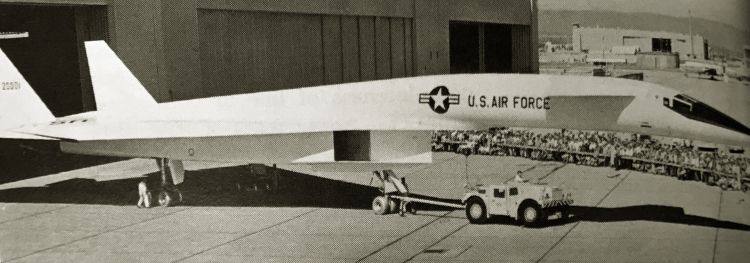
This picture, from the November 1964 issue of Modern Machine Shop, shows North American Aviation’s new XB-70A airplane being rolled out from its hangar. It’s from the cover story of the issue, which was about machining the mechanical “brains” of this supersonic jet prototype.
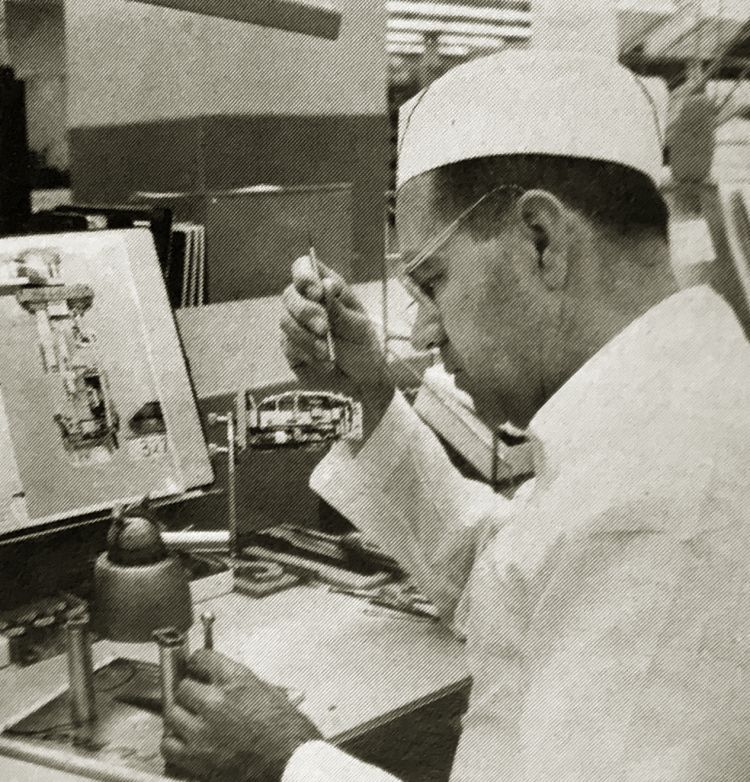
A technician makes final adjustments on an assembled force-balance Mach transducer, which the article notes was made on “rather conventional shop machines and grinders.” Setup techniques and accurate gaging were used to achieve the precision required for these parts.
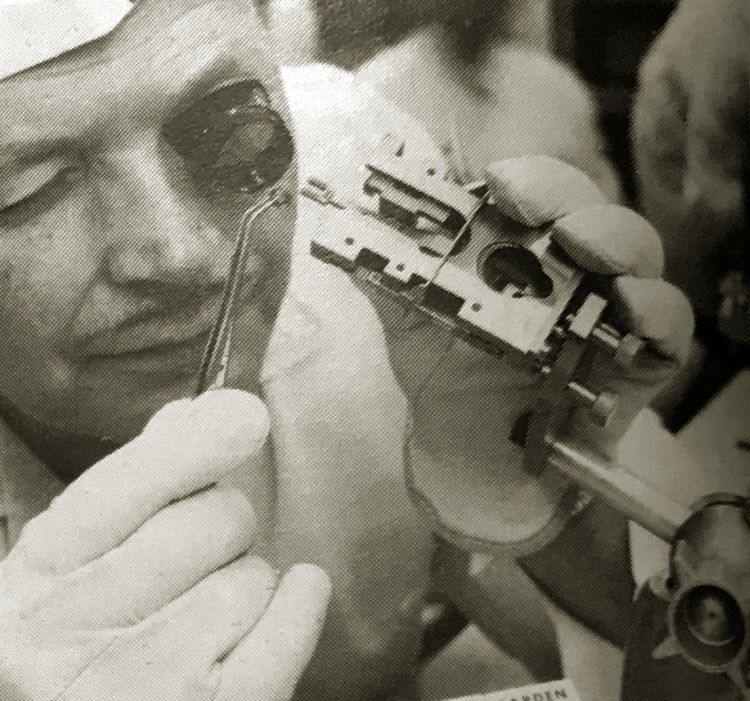
A technician installs a bearing in a force-balance Mach transducer for a North American Aviation XB-70A airplane. These parts were made to specifications including machining within 0.0002 inch for non-sensitive components and 0.0001 inch for others; flatness deviation of no more than 0.00005 inch on some parts; and axial deviation within 0.00001 inch on certain bearings, all without the use of NC technology.
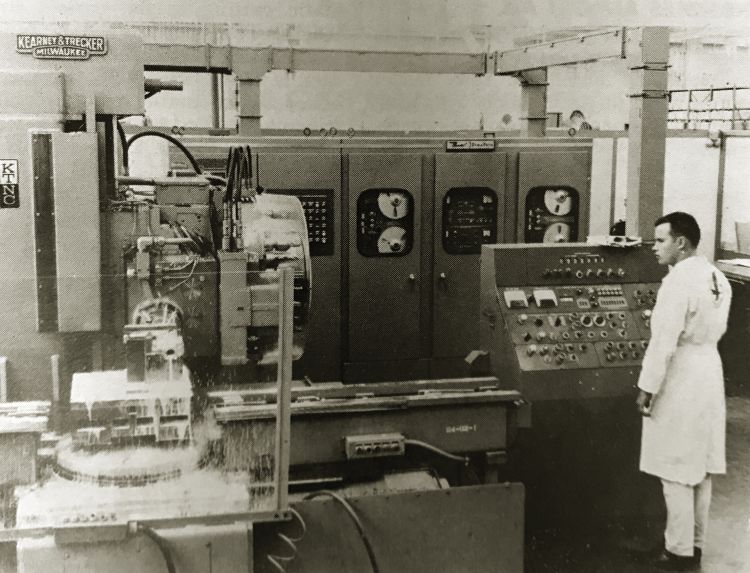
The next article in the issue was the first in a refresher series on numerical control. This picture shows a Universal DynaPath NC console from The Bendix Corporation’s Industrial Controls division controlling a Kearney & Trecker Milwaukee-Matic No. 2 at Bendix-Pacific division located in North Hollywood, California.
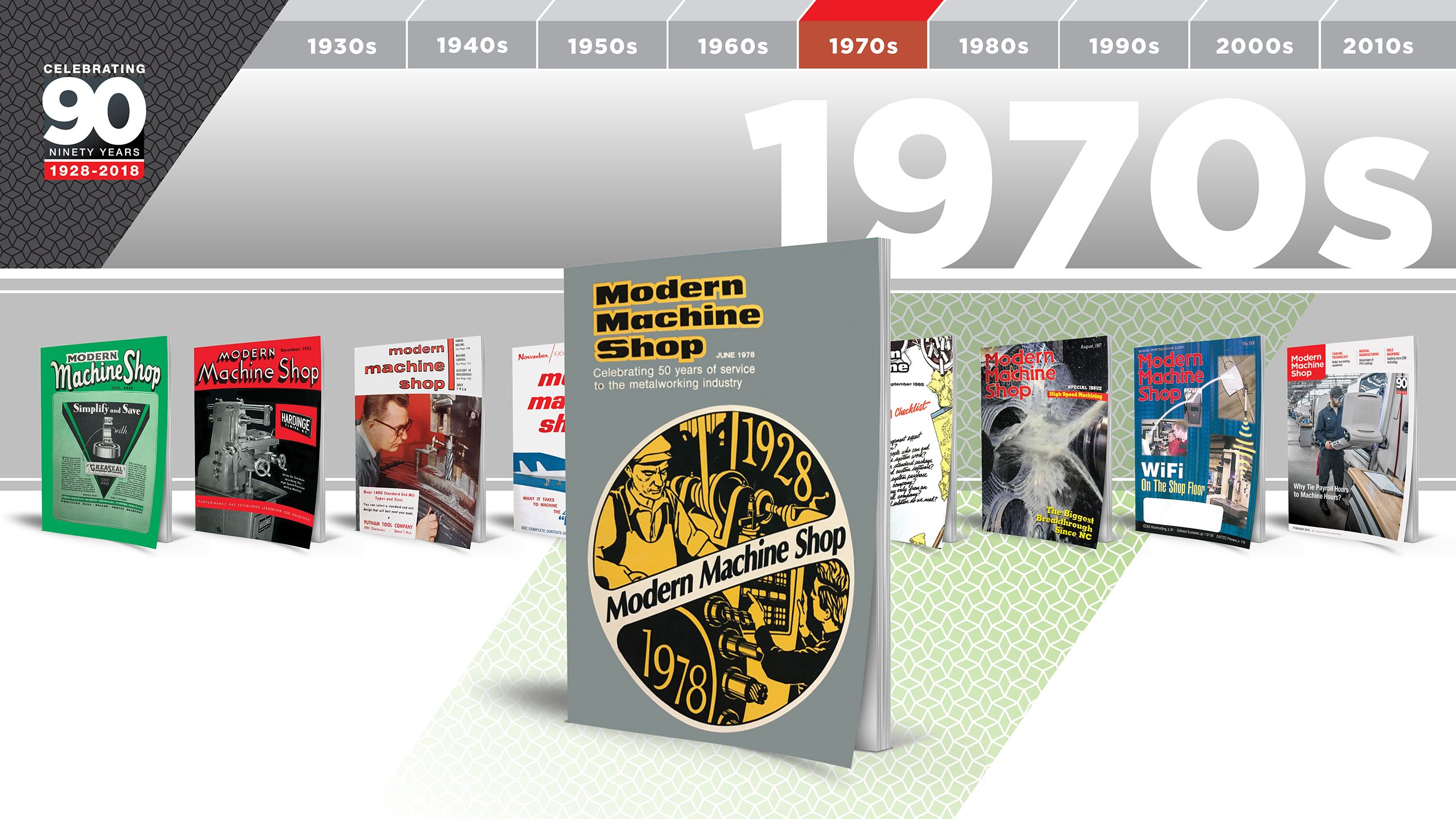
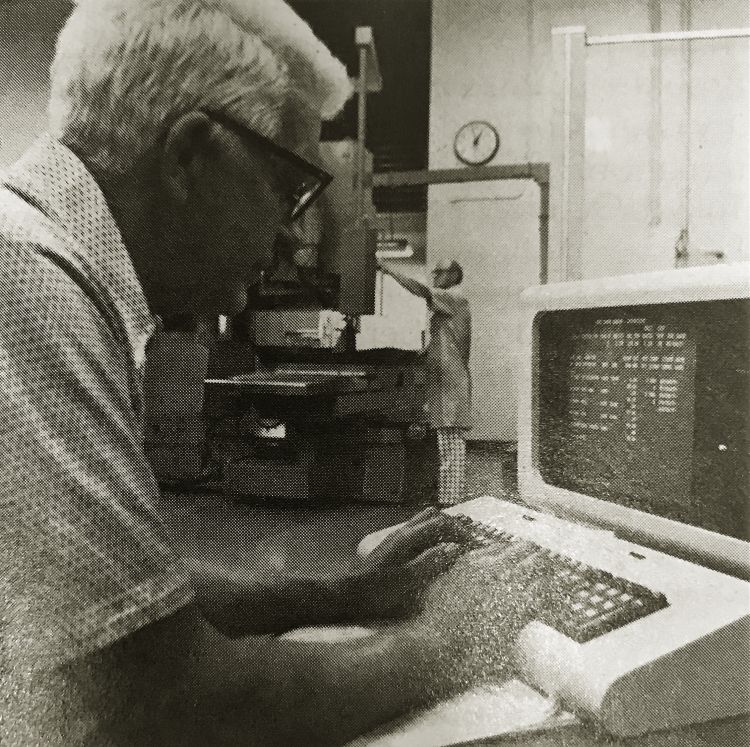
In 1978, Modern Machine Shop celebrated its 50th anniversary. In that year’s June issue, editors looked back at the world events, topics, trends and technologies the magazine covered throughout the years. The section on the 1970s shows evidence that computers were becoming a major trend in manufacturing.
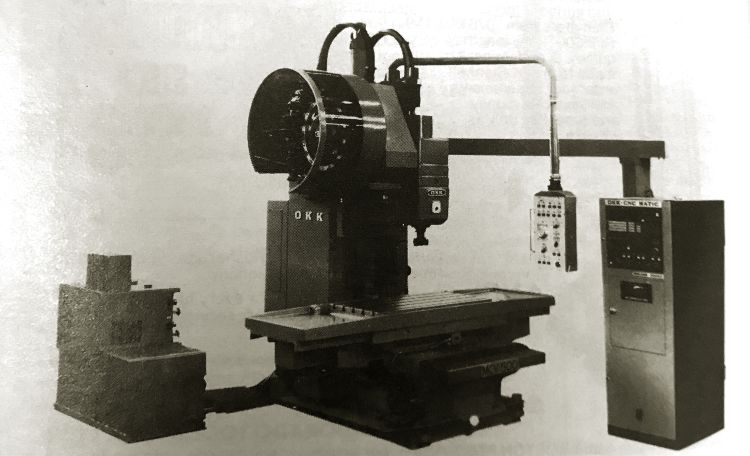
According to the June 1978 issue’s retrospective, CNC remained an important topic throughout the 1970s. The article states that the technology dominated the 1976 International Machine Tool Show, which is now known as the International Manufacturing Technology Show (IMTS). This 1978 photo shows an OKK CNC-Matic.
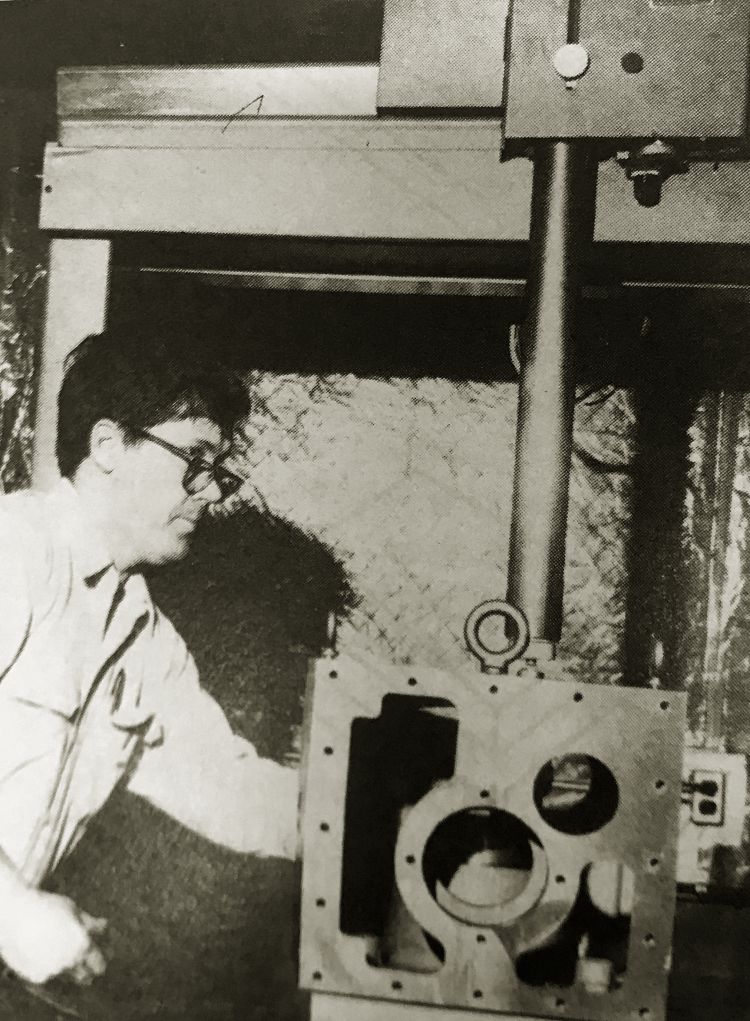
The June 1978 issue also included an article in which an industry expert gave predictions about how computer technology would affect the future of machining. This photo from the same year shows an operator making a probe of a bore. A switch in his right hand enabled him to enter data, which was then stored in a computer.
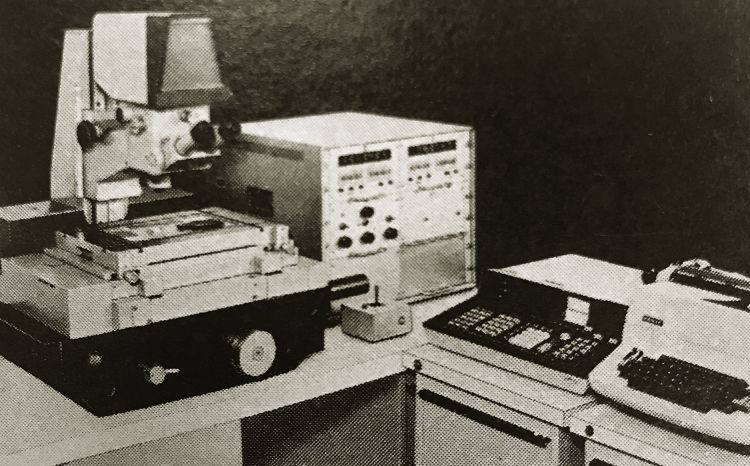
In the June 1978 issue of Modern Machine Shop, an industry expert predicted that by the year 2000, computer-integrated automatic factories would be a reality. This photo from the same year showcases one of the uses of computers at the time—for use with coordinate measuring machines.
When We Looked Back and Forward
Derek Korn | Executive Editor
The June 1978 edition of Modern Machine Shop was significant in that it was the 50th anniversary issue. Its cover imagery as shown above portrayed both a bit of nostalgia (belt-driven machine tools) and a bit of foreshadowing (the advent of computer technology applied in manufacturing).
For that issue, the editors created a yearly-diary-like article citing world events, changes that had been made to the magazine, and topics, trends and technologies that were covered in each of the magazine’s 50 years. The section about the 1970s offers evidence that digital computer technology would start to be implemented in manufacturing operations in significant ways. For example, the 1974 blurb says it “looks like the CAD/CAM concept is becoming a ‘buzzword’ as an outgrowth of numerical control (NC). I can see the real beginning of high interest in the use of the computer for the entire plant manufacturing environment.” The 1976 blurb points to the “dominance of computer numerical control (CNC) at the International Machine Tool Show,” known today as the International Manufacturing Technology Show (IMTS).
Therefore, it is not surprising that in the era when the impact of new CNC machine tool technology was just starting to be felt, the subsequent article in that issue titled “Computers Advancing World Manufacturing Technology” features an industry expert’s predictions about how computer technology would change the face of machining and manufacturing in the years to come. Dr. M. Eugene Merchant, the director of research planning for Cincinnati Milacron at the time said:
- By 1980, a computer software system for full automation and optimization of all steps in the manufacturing of a workpiece would be developed and in wide use.
- By 1985, full online automation and optimization of complete manufacturing plants controlled by a central computer would be a reality.
- By 1990, more than 50 percent of the machine tools produced would no longer “stand alone.” Instead, multiple machines would be grouped in cells (he did not use that word) with material-handling systems that would be controlled by a central computer.
- By 2000, the “computer-integrated automatic factory” would be a full-blown reality.
There would be two major productivity-enhancing incentives for establishing such an automated, computerized shop, Dr. Merchant said. The first would be to “reduce the time workpieces spend in process in the shop. This would reduce the high and costly inventory of unfinished parts on the shop floor and of finished parts waiting for others in process so that assembly of the product could proceed.” The second would be “vastly improved machine tool utilization.”
To this day, these remain important manufacturing goals for shops, and shopfloor practices based on the power of today’s computers and software (as well as tablet devices and apps) continue to be devised and applied to achieve them. However, when he talked about automation, was he thinking primarily in terms of robotics and “hands-free” flow of parts from machine to machine through a facility? An artist’s rendering of an automated machining cell in the article suggests this. Clearly, there are some advanced manufacturing facilities that do function as such with minimal human intervention. However, there are still many shops today in which there is no robot to be seen. Plus, it is ironic in that new collaborative robots featuring designs that enable a human to work safely alongside them are becoming increasingly popular.
That said, there are other elements of automation that shops can leverage to reduce overall production time and improve machine utilization. For example, on-machine probing technology can automatically measure cutting tools and determine if a tool has broken as well as probe workpieces to speed setups or measure machined features to detect if the process is trending out of specification. Presetters can similarly automatically measure tools outside the machine. Bar feeders and parts collectors on turning centers enable long stretches of unattended machining. Five-axis and turn-mill machining are forms of automation in that they can machine multiple part features (sometimes all part features) in one setup, eliminating the need for operators to set up those parts on multiple machines. Sensors mounted on some of today’s machine tools feed information to enable a CNC to automatically change parameters depending if the data suggests there is a problem.
Ultimately, though, it seems Dr. Merchant was predicting how computer technology would serve to connect disparate elements of manufacturing as that rendering in the article also suggests. Given the level of connectivity that has been established not only in manufacturing, but myriad aspects of our personal lives, I would say he was spot-on in that regard.
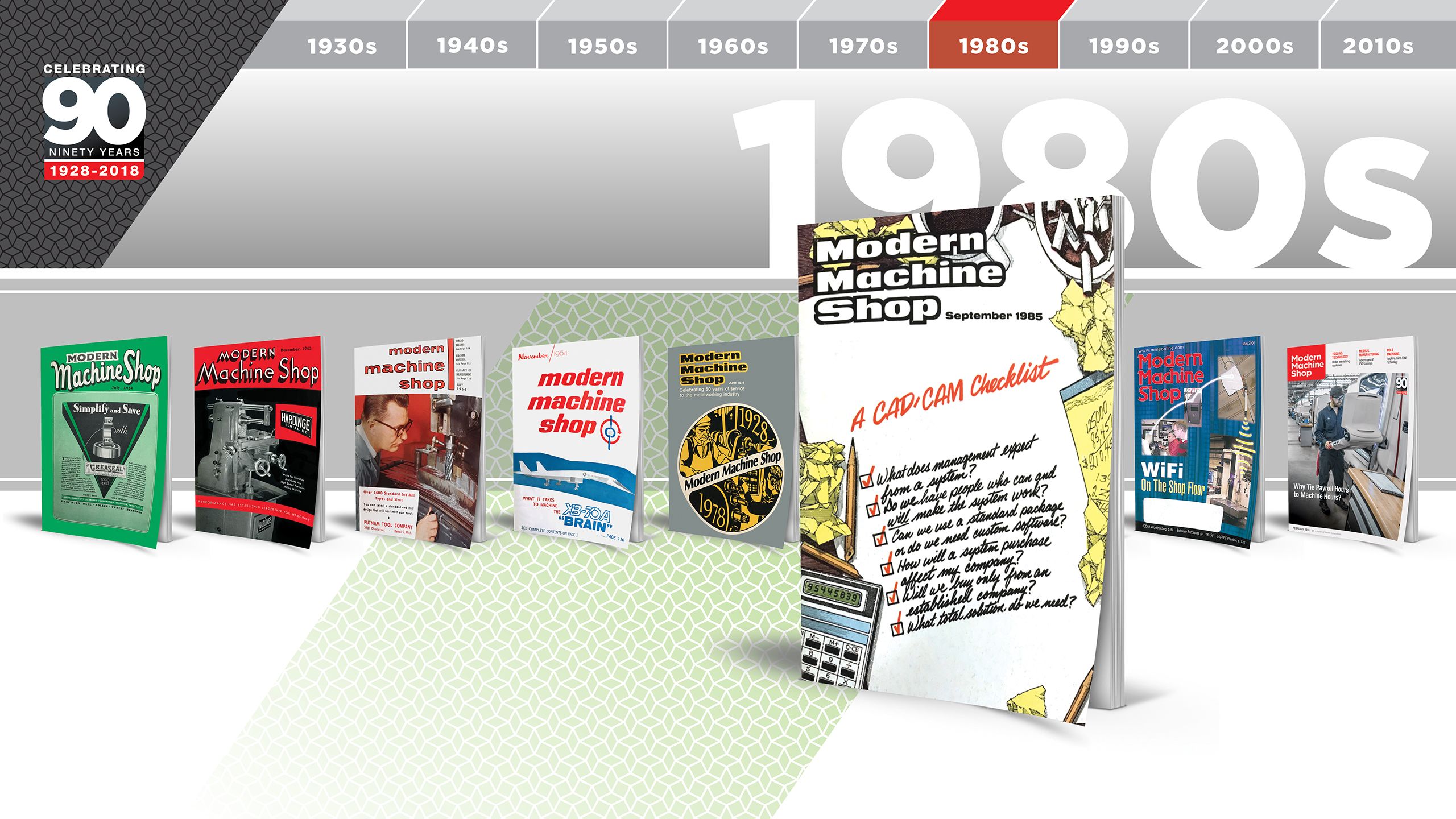
Computerization Changes Everything
Mark Albert | Editorial Director
The proliferation of the computer numerical control (CNC) machining center in the late 1970s signaled the total eclipse of the manual machine tool in the following decade. Very few shops would still rely on standard, “conventional” machines for anything but toolroom work by the end of the 1980s. However, the rise of the computerized machine tool marked an even broader shift in machine shop operations. Computerization came to a wide range of other manufacturing functions (“applications” as we refer to them now) on the shop floor and in the front office.
For the first time, running the manufacturing business and running the production machines would be influenced by a single, powerful technological advance—the personal computer (PC), which was often called a microcomputer around that time. Also for the first time, our industry would be dependent on advances coming from outside the metalworking or manufacturing world. General hardware and software developers such as IBM and Apple Inc. were in the lead, while applications for industrial design and manufacturing followed closely in response. The umbrella term for these applications was clearly “CAD/CAM,” but CAD/CAM was essentially a collection of specific uses for digital technology that was emerging.
Just how prevalent and dominant CAD/CAM had become is strikingly evident in our September 1985 issue. Almost the entire magazine, it seems, is devoted to manufacturing software: computer-aided design (CAD); computer-aided manufacturing (CAM); material requirements planning (MRP); statistical process control (SPC) and other vital applications. However, the cover story, “A CAD/CAM Checklist,” is emblematic.
The content of this article, authored by Paul Olsen of GrafTek, was conveniently summarized on the cover itself. It is apparent that this article was directed to company management (that is, business owners), who were advised to consider how several departments within the company would coordinate or interact via the CAD/CAM system.
Inside the article, the author raises a number of additional management and technical issues (in a way that seems somewhat superficial and generalized to me today). Several are noteworthy, given the relevance of these same issues in the present. For example, exchange ability and interoperability were just as likely to be barriers in 1985 as they are now. The Initial Graphics Exchange Specification (IGES), which had been introduced five years earlier, was cited as an important solution. Maintaining a CAD/CAM system with updates and new releases from the developer was mentioned as a discussion point. That is still true 30 years later. The idea of sharing data among applications via a centralized database earns only a few sentences in this article—the details of communication across a network are not discussed (at the time, most shop networks relied on serial ports and RS-232-C capability).
The article gives a glimpse of the state of computer technology in the mid-1980s. For example, it points out that 32-bit processors were displacing 16-bit products. 2D drafting had evolved into 3D wire frames, but solid modeling capability (available and recommended by the author) substantially upped the cost and system requirements, so it prompted this cautionary note:
“If the added capability is not needed, don’t buy it.”
Browsing the other articles and advertisements in this issue provides a much richer picture of the manufacturing software and hardware landscape of the time. IBM PC, XT and AT personal computers were vying with Apple Macintosh II and IIe models. Digital Equipment Corp., maker of the VAX and PDP-11 “minicomputers,” was also a major hardware supplier, as was Hewlett Packard. PC-DOS, MS-DOS and CP/M were in contention as operating systems. (Microsoft Windows, one of the early graphical user interfaces for PCs, would be released by the end of the year.) The 5-inch floppy disk was giving way to the 3.5-inch diskette (which, oddly, is still the universal icon for the “save” function in today’s software).
For machine shops, punched-paper-tape equipment and time-sharing for automatically programmed tool (APT) processing of NC programs were still around, but fading.
At Modern Machine Shop, editors were working with word-processing systems, and learning the hard way that frequently saving long documents to the disk was very, very important.
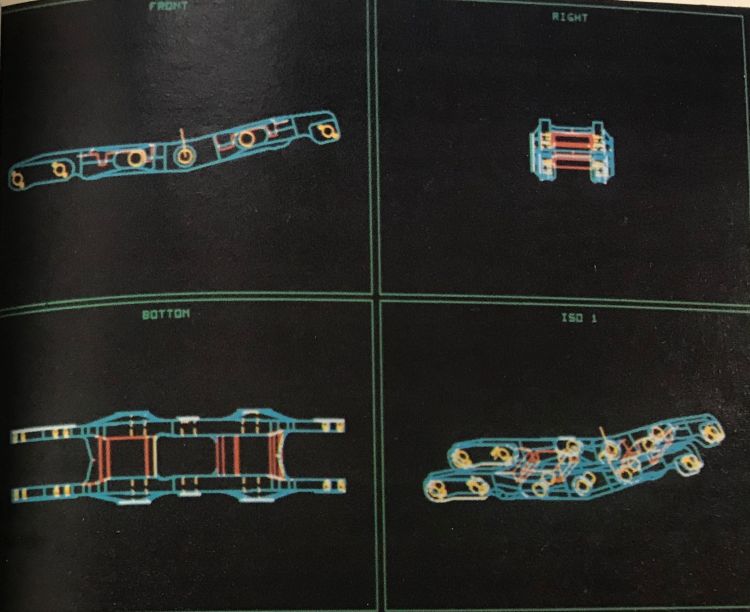
The invention of the personal computer (PC) had a big influence on manufacturing in the 1980s. This is reflected in the September 1985 issue of Modern Machine Shop, which was almost entirely dedicated to manufacturing software. This image from that issue shows how a 3D database enabled a user to view a model from any angle.
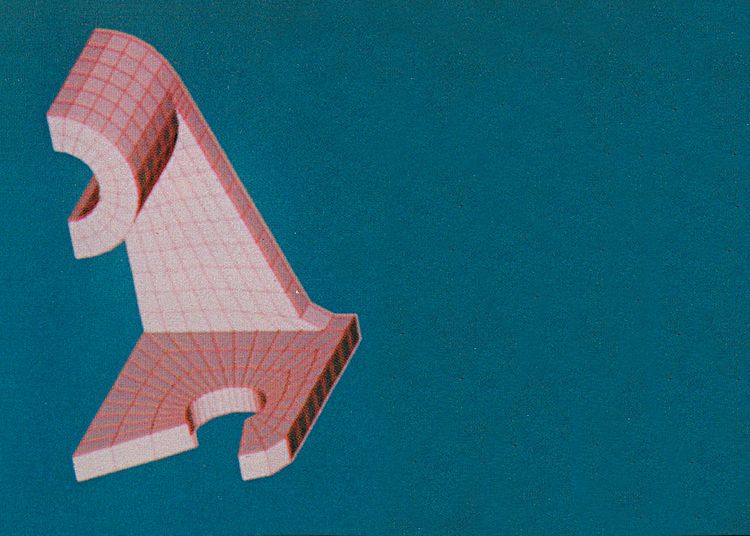
The cover story of the September 1985 issue of Modern Machine Shop was titled, “A CAD/CAM Checklist.” It raised management and technical issues for company management and business owners to consider when implementing a CAD/CAM system that works with graphic representations like the one shown here. Its shading was said to help determine the validity of the underlying geometric model.

Many issues with CAD/CAM systems in the 1980s are issues users still face today, including exchange ability and interoperability, and maintaining systems with updates and new releases. Despite these challenges, CAD/CAM software provides many valuable capabilities like numerical control programming, which is seen here.
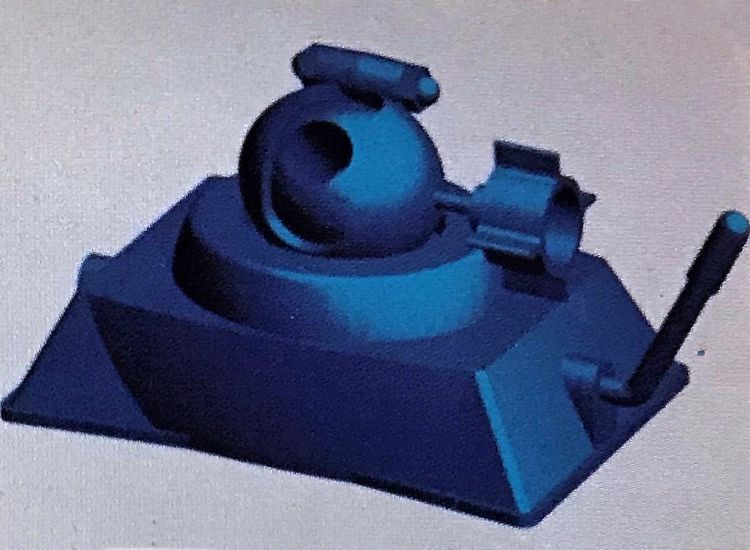
The article also gives us a look into the state of computer technology in the mid-1980s. Among other things, it pointed out that while 2D drafting had evolved into 3D wireframes, solid modeling capability, like the high-resolution model seen here, substantially increased costs and system requirements.
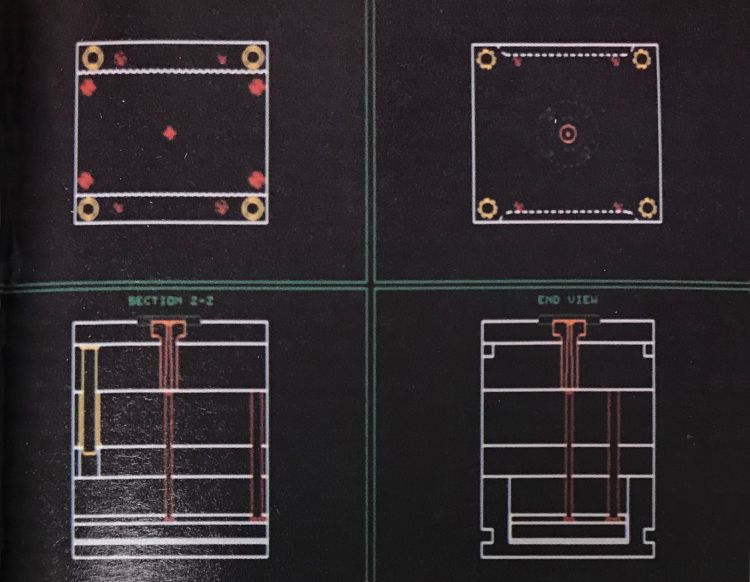
Based on the other articles and advertisements in the issue, users had a range of hardware and software to choose from. Personal computers from companies like IBM, Apple, Digital Equipment Corp. and Hewlett Packard, along with PC-DOS, MS-DOS and CP/M operating systems were used for tasks like modeling the above mold base.
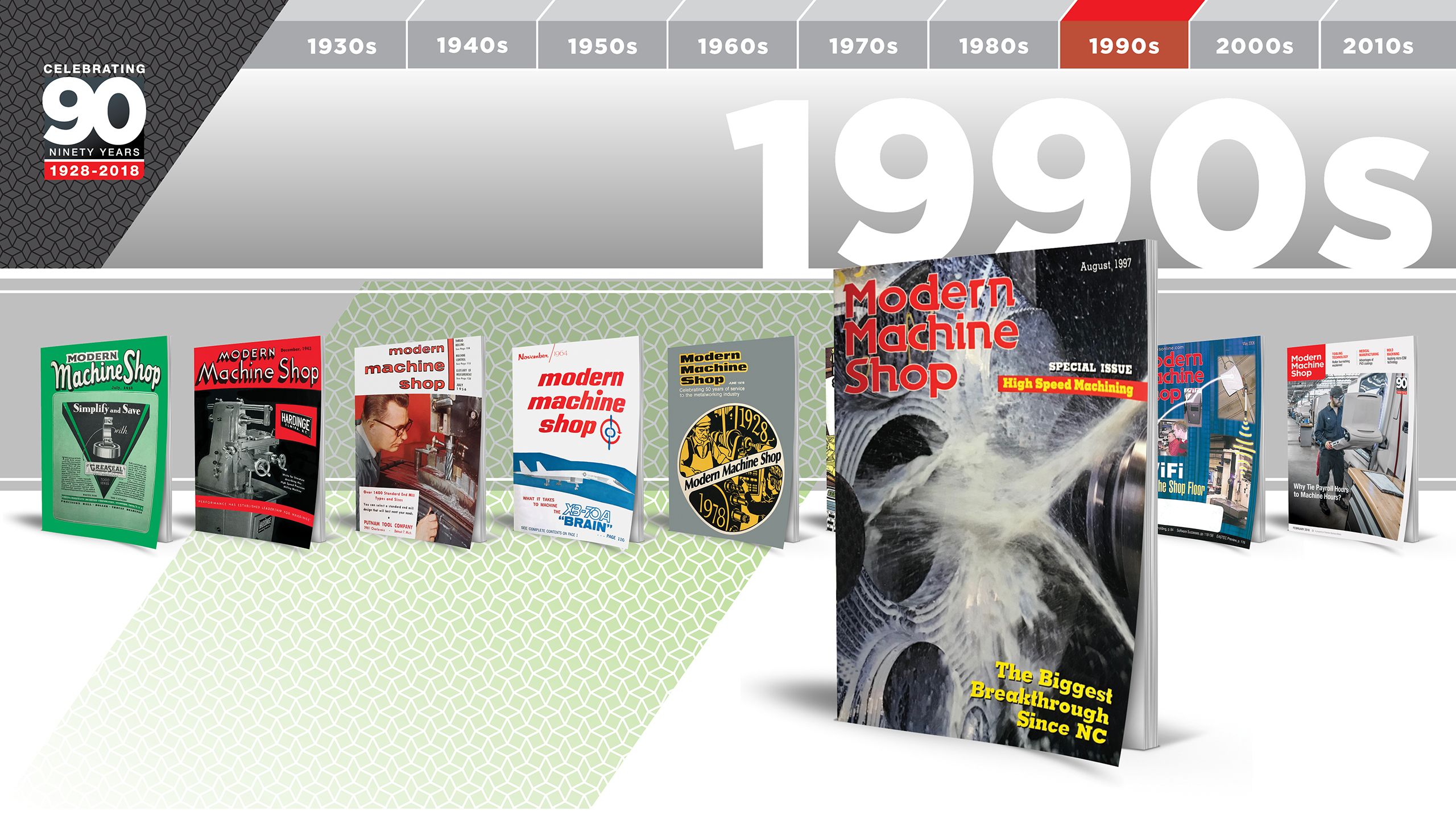
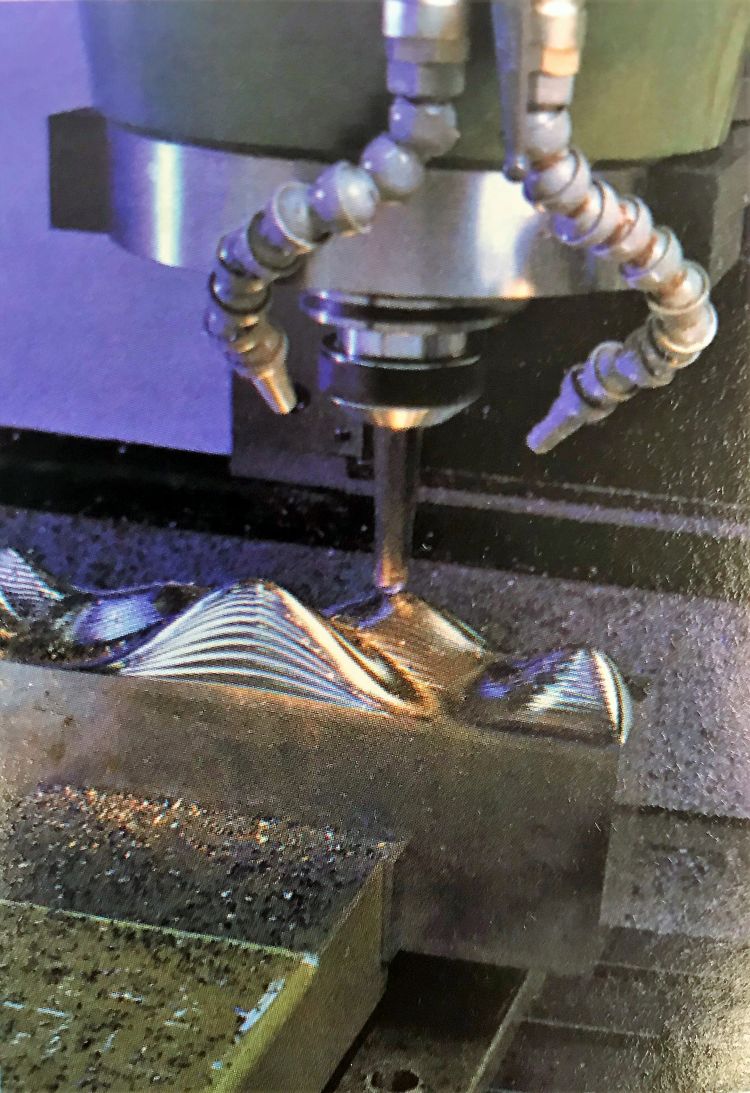
The August 1997 issue of Modern Machine Shop was entirely devoted to high-speed machining, with 10 feature articles covering topics like programming, balancing cutting tools and pushing existing machinery to new limits. The cover heralded the technique as “The Biggest Breakthrough Since Numerical Control.”
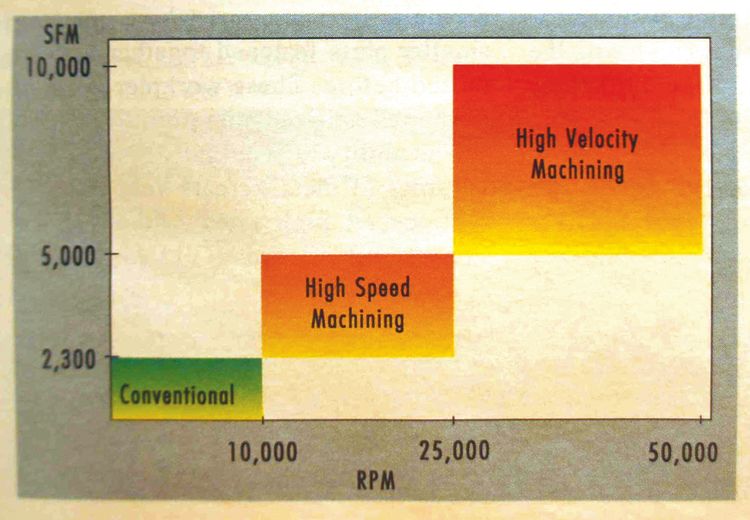
This graph shows how a group of German researchers viewed the cut-off between conventional and high-speed machining, and between high-speed and “high-velocity” machining.
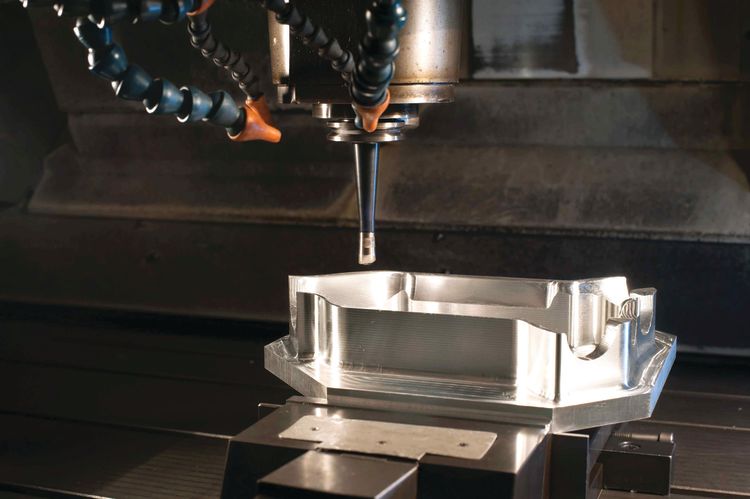
High-speed machining means different things in different contexts. In mold machining applications like this one, it typically denotes fast, light cuts in hard metals. For aerospace applications, however, the focus is often on leveraging harmonics to avoid chatter.
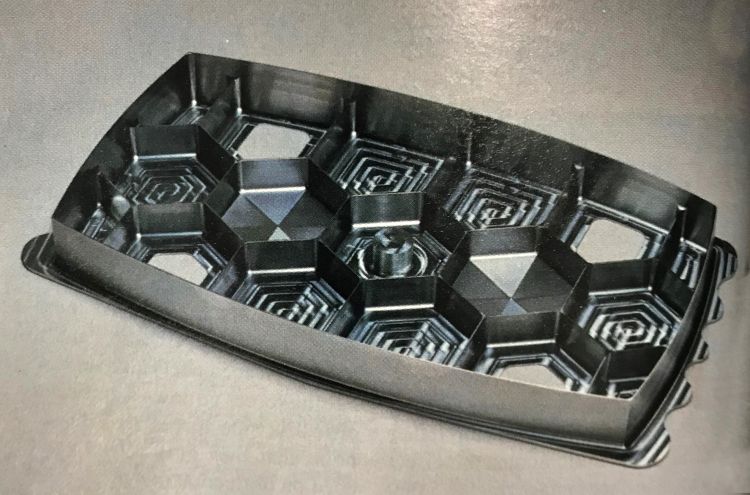
Original caption from the August 1997 issue of Modern Machine Shop: Using five different cutting tools at up to 10,000 rpm with up to 300 ipm feed rates, this honeycomb part was machined out of 6061-T6 aluminum. Walls and floor are 0.030 inch thick. Straightness of the inner walls as well as flatness of the floor improve at these high feed rates.
High-Speed Strategies for a High-Speed World
Matt Danford | Senior Editor
Modern machine shops are built on a long legacy of technological innovation, but the digitalized, interconnected manufacturing world we know today first became tangible in the 1990s. Firewalls and intranets; personal-computer-based controls and 3D part files; email, e-commerce and e-everything—all of this was new and strange to shops competing in an era of accelerating globalization, rapidly advancing information technology and, at least in the United States, widespread economic prosperity.
For some, however, sharing in that prosperity was about more than developing that first website. It was about more than complying with new global quality standards or adopting “black-art” technologies like EDM that were becoming more accessible. Gains from advances in computing filtered all the way down to the interface of cutting tool and workpiece, with forward-thinking shops beginning to mill faster and more shallow than ever before.
In August 1997, less than a decade after the term “high-speed machining” first appeared in these pages, Modern Machine Shop heralded the burgeoning technique as “The Biggest Breakthrough Since Numerical Control.” That issue is devoted entirely to high-speed machining, with 10 different feature articles covering topics ranging from programming to balancing cutting tools to pushing existing machinery to new limits.
Regardless of whether that cover’s tagline rings true in hindsight, high-speed machining would become the process of choice at countless aerospace and tooling shops throughout the next two decades. At the time, however, applications were limited. “Maybe your biggest question is: ‘Why do I need this technology at all?’” wrote then editor Tom Beard in his monthly column. “While it’s hard to say just how broadly high-speed machining will eventually be applied, it’s a pretty safe bet that competitive standards for machining rates are going to follow the leading-edge applications upward. Faster feeds and speeds are somewhere in your future and may be closer than you think.” (Mr. Beard is now director of custom content at MMS publisher Gardner Business Media.)
Thanks to the participation of a few early adopters, the articles that followed covered not just theory, but also practice—real-world applications that are remarkably similar to many covered in MMS today. Although the underlying technology has become far more capable, much of the wisdom in these articles (which were among the first to appear on mmsonline.com) remains as applicable today as ever. Here are a few examples:
Definitions Are Nebulous
High-speed machining “means different things to different people,” stated Mark Albert, who is now Editorial Director, in the opening article of August 1997’s special coverage of the topic. Parameters today are generally more aggressive, and as was the case when that issue was published, different shops contend with different lot sizes, materials and specifications. A better indicator of success is whether high-speed machining tactics facilitate a significant change in the overall process. For instance, one shop covered in the issue was an automotive manufacturer realizing speeds fast enough to move production from dedicated transfer lines to more flexible machining centers. Another was a moldmaker using the technique to reduce EDM burning and manual polishing. A third story covered an aerospace manufacturer using the technique to cut thin walls, and to cut single, large parts rather than multiple components for later assembly. Although novel at the time, high-speed machining would soon become common in applications like this.
All Elements Are Interlinked
The issue directed significant focus to the computer numerical control (CNC) and computer-aided manufacturing (CAM) software advances that made high-speed machining possible. One article gushes that programs might require “huge amounts of data—10 megabytes is not uncommon,” and that “an Ethernet network might be required to download programs of this size efficiently.” CAM systems were beginning to offer tool paths designed to avoid sharp directional changes and maintain a constant cutter load. More fundamentally, higher-than-ever block-processing speeds (“less than a millisecond” in some cases) were enabling CNCs to anticipate motion and adjust acceleration, deceleration and other parameters accordingly.
Successful high-speed machining required mechanical elements to evolve as well. “Virtually every aspect of the servo-control system has been upgraded,” Mr. Beard wrote in an article covering how machine design was changing. Linear motors and guides were just beginning to be considered for machine tools. Spindles driving tools faster than 10,000 rotations per minute required non-greased bearings to prevent problems with heat, so oil-lubricated bearings with ceramic rolling elements and steel inner and outer races were the order of the day. An article devoted specifically to cutting tools mentions various technology that is still common today, such as shrink-fit toolholders and HSK interfaces that ensure stability through simultaneous contact with spindle face and taper. “High-speed machining is a system, with its many components interlinked,” wrote then Senior Editor Chris Koepfer, articulating a central theme of various high-speed machining articles MMS would publish in the ensuing years (Mr. Koepfer is now editor-in-chief of MMS sister publication Production Machining).
Application Stories Are Appreciated
A rising tide lifts all boats, as they say, and Mr. Koepfer used his monthly column to thank sources, particularly the end users covered in the application stories. “Many might think it’s not in a shop’s commercial interest to divulge proprietary information—which high-speed machining could be considered,” he wrote about the “best in industry” attitude of the subjects of that month’s application stories. “It was a generous thing for them to share information about how they machine at high speed.”
“Getting the insight we did in preparing these stories for our audience of more than 106,000 demonstrates that quite a few people in our industry see the bigger picture. It’s not about one shop beating out another. If everyone manufactures better then manufacturing is better for it.”
These comments may as well have been written yesterday. If you have a story you’d like to see told in Modern Machine Shop, whether about high-speed machining or another topic, contact an editor at press@mmsonline.com.
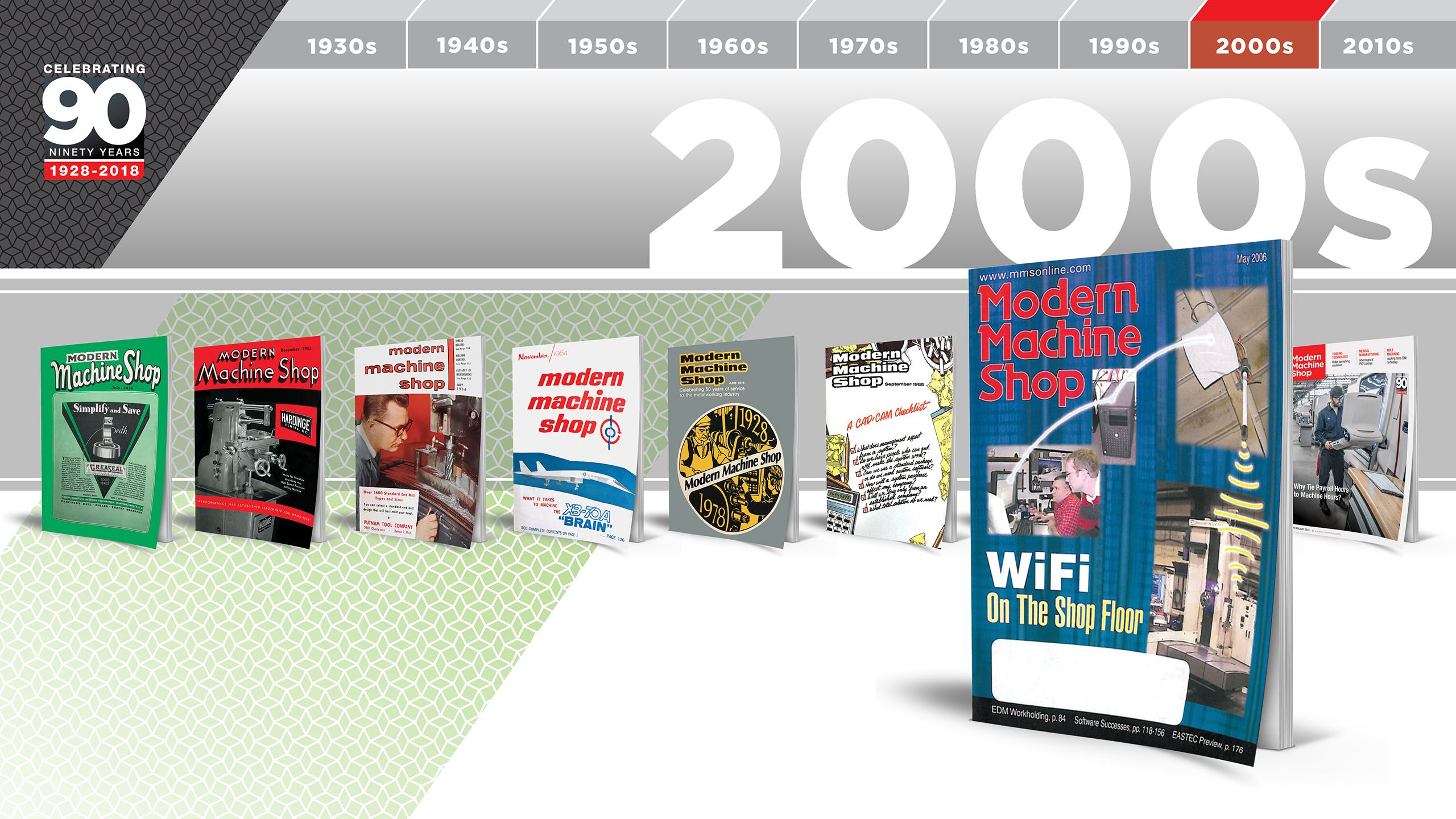
Increasing Connectivity
Stephanie Hendrixson | Associate Editor
Let’s get one thing out of the way first: I am a millennial. I am part of the generation that has been influenced heavily by the rise of social media, smartphones and the internet. I like to think I have paid my dues: I remember passing handwritten notes and calling friends on landlines, and the first time I accessed the internet was via a dial-up connection. However, I cannot deny the growing presence of technology over my life span. Perhaps it is fitting that I landed the assignment of writing about the 2000s, a decade of increasing connectivity in both private life and the machine shop world.
The May 2006 issue cover story, titled “No Wires, No Worries,” is about Miller Welding & Machine’s experience installing a Wi-Fi network in 2005. Miller was not the first manufacturer to do so, nor was this issue the first time that Modern Machine Shop covered wireless networking in machine shop environments. However, the reason for Miller’s Brookville, Pennsylvania, shop to go wireless at precisely this moment was that wired connections to its machine tools had, quite literally, backfired: A lightning strike that hit its main plant in October 2004 destroyed circuit boards inside computer numerical control (CNC) units, leading to several days of downtime and thousands of dollars needed to get the machine tools back up and running. A wireless networking system, therefore, seemed like an appealing option.
The rise of wireless connectivity on the shop floor in the 2000s was perhaps the natural evolution of direct numeric control, which connects machine tools to a centrally located computer that stores and distributes part programs. Distributed numerical control followed, a similar setup in which a network of computers coordinates the operation of multiple machines, feeding programs into CNC memories where they can operate independently. Both networked concepts eventually came to be known as “DNC,” and it was only a matter of time before wires began to vanish from the equation.
At least for Miller, that was the case. The company had been on its way to implementing wired DNC before the lightning strike, but that event made cutting cords to machines a priority. So instead of hardwiring, the machine tools at the Brookville facility were equipped with wireless DNC devices to enable server access over Wi-Fi, by way of access points installed throughout the building.
Installation and setup were successful, but integrating Wi-Fi did not come without worry and concern: Would it be reliable? Fast enough? Secure?
Fortunately, even more than a decade ago, the answer to each of these questions was “yes.” At the time of print, Miller reported no problems with downloading numerical control (NC) programs wirelessly, and download speeds were adequate for its needs. Data encryption and other security measures kept NC programs safe from interception and Miller’s corporate network safe from attack.
Machine shops in 2018 have even better means of answering these questions. Reliability and speed have improved with more advanced hardware and software and faster internet connections. Shops today have their pick of network-ready equipment with built-in Wi-Fi and Bluetooth capability. The MTConnect protocol, which rolled out in the later 2000s, has made data gathering and analysis easier. Data security is perhaps the most pressing issue today; though cyberattacks on machine shops are rare, the stakes remain high. Fortunately, measures such as hardware firewalls, encryption and even cybersecurity insurance policies can provide peace of mind about using Wi-Fi on the shop floor.
The cover story of this issue is not just about the promise of Wi-Fi, however. It is what Wi-Fi represents: connectivity. For a machine shop in the mid-2000s, connectivity meant capability to send NC programs anywhere in the building from a central file server; the ability to move machines at will without rewiring the entire network; and the opportunity to connect other devices—like a portable coordinate measuring machine—to the same network wirelessly.
For shops today, connectivity extends even further. Flip through a recent issue of Modern Machine Shop and you will see ads, product listings and case studies for everything from tool-vending machines that feed data back to enterprise resource planning systems to Bluetooth-enabled probes to smartphone apps that support round-the-clock machine monitoring. For better or worse, we are more connected now than ever before.
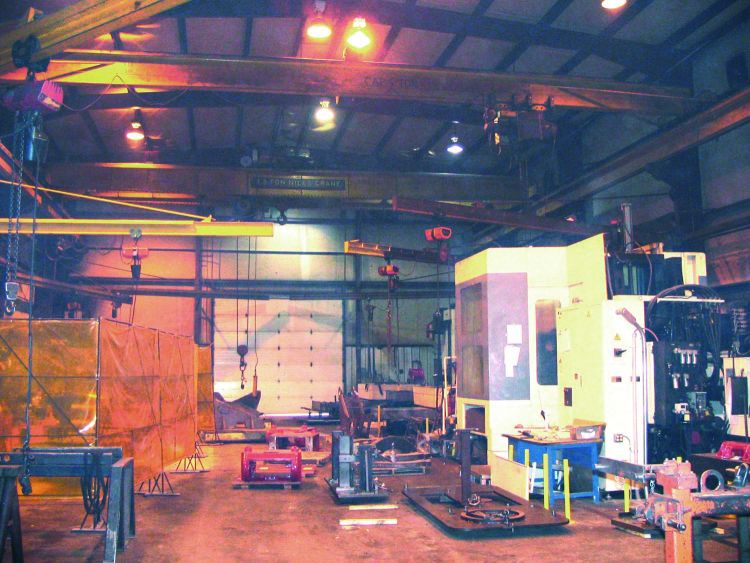
The May 2006 issue of Modern Machine Shop featured a cover story titled “No Wires, No Worries,” which covered Miller Welding & Machine’s experience installing a Wi-Fi network in 20015. The Brookville, Pennsylvania shop made the decision to go wireless after a lightning strike destroyed circuit boards inside computer numerical control (CNC) units.

The wireless DNC “kit” Miller Welding & Machine added to its machine tools in the mid-2000s included (from left to right) a whip antenna, radio network card, socket connector and communications interface device. Today, one-device solutions exist for bringing machines into a wireless DNC network.
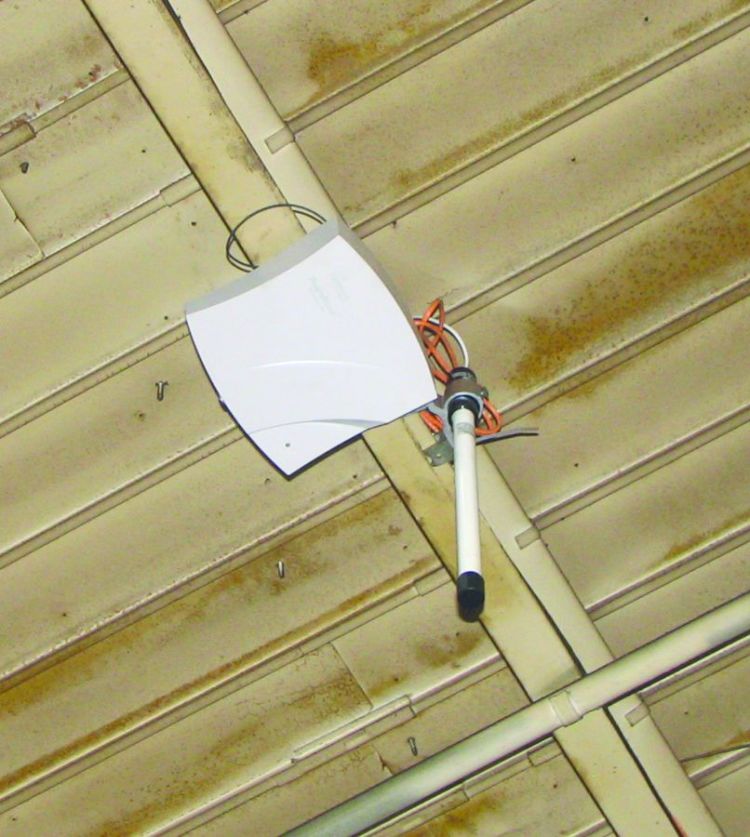
A wireless access point and antenna mounted to the ceiling at Miller Welding & Co. The machine tools were set up to communicate with this access point via Wi-Fi, with the access points being hard wired into the server.
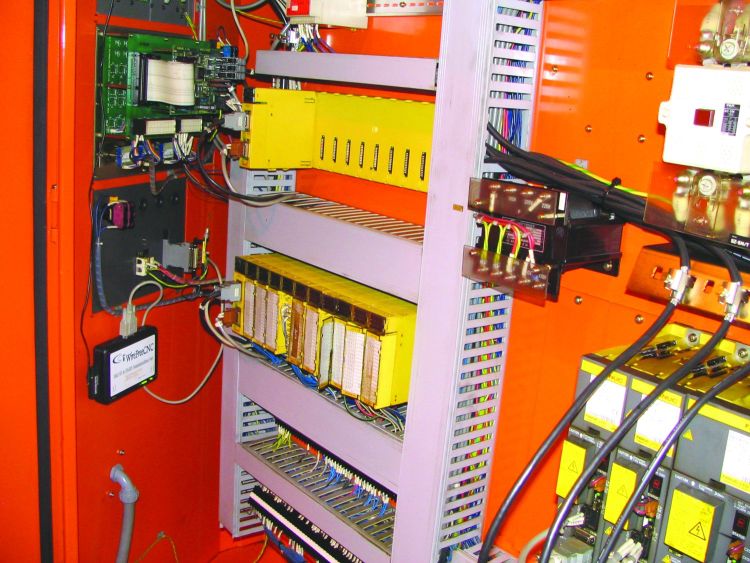
Items from the "kit" were installed in a machine tool's electrical cabinet. The installation and setup were successful, and the company reported no problems with downloading numerical control (NC) programs wirelessly.
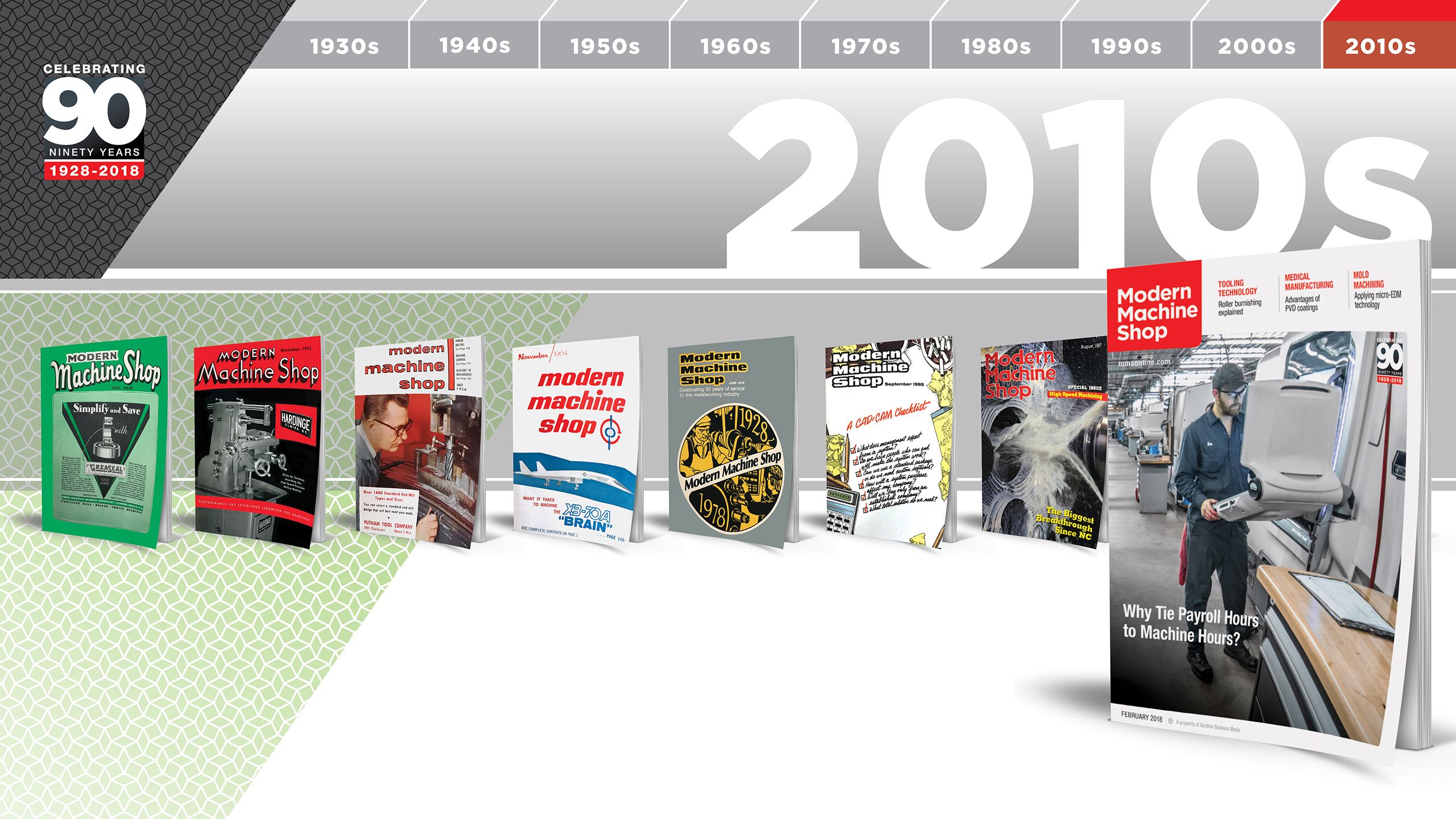
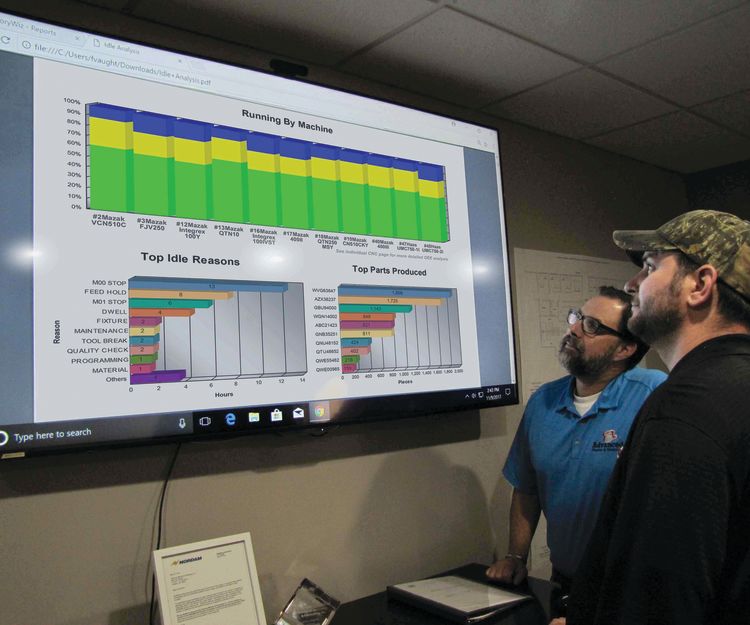
Here is a way to understand the process that is becoming more common in machine shops: visualization of performance based on machine-monitoring data. The shop seen here is Advanced Machining & Fabricating of Oklahoma.

The January 2018 issue of Modern Machine Shop featured R&D Manco. The company's manufacturing engineer Luis Hernandez is dedicated to analyzing machine monitoring data.
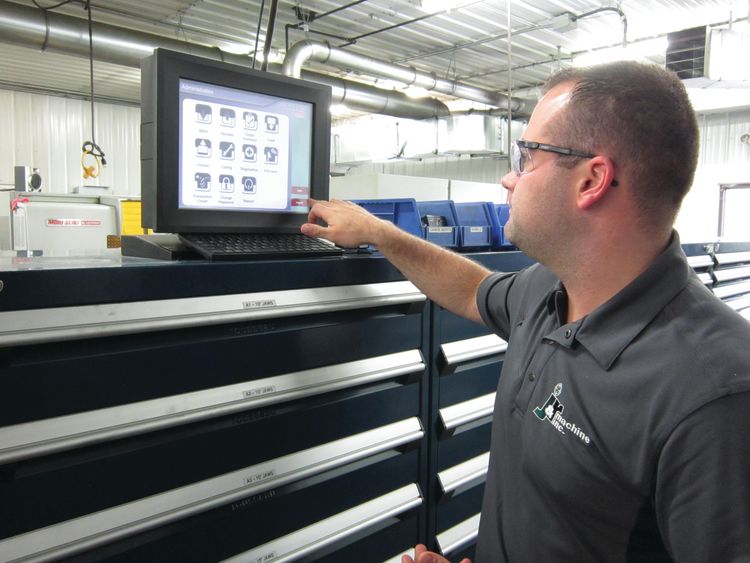
Parker Tumanic of J&R Machine, which was featured in the February 2018 issue of Modern Machine Shop, shows a tool vending system that tracks tool costs to job numbers.
The View Ahead: How Far Will Digital Advances Go?
Peter Zelinski | Editor-in-Chief
And now we come to 2018. Since the decade of the 2010s isn’t done, it is too soon to know what part of our experience now will catch the future’s attention. One defining feature of this decade can be found in the way it began, with effects still being felt from the preceding decade’s trials. The Great Recession left machine shops struggling to return to their previous levels of success, and as of 2010, many were still on that upward climb. But then at a certain point in this decade a threshold was crossed. Shops regained their previous levels and kept going.
Now, how are those shops changing and where are they headed? This year, we saw a clue. The cover stories of each of the first three issues of this year (including the one seen here) all reported on shops making significant investments toward bringing their equipment and capabilities together into unified digital systems. The repetition of this digital theme was not our intent. For our first cover story of the year, we aimed to report on a shop’s success with transitioning to machining from solid as a replacement for relying on casting. But committing to a system of digitally monitoring machine-tool performance and responding to the data proved vital to the shop’s aim to become more reliant on CNC machining.
As for where this development of digital integration might go, I think we can see clues to this in other industries. In retail, for example, a third-party provider might seamlessly fulfill an order placed through Amazon; we are already accustomed to this. If manufacturers’ internal digital integration can naturally extend into external integration as well, we might see shops as nodes within data-sharing supply chains that receive and fulfill part orders as seamlessly as the integration in retail already shows. A term in 2018 for talking about the promise of shifts such as this is “Industry 4.0.” What currency will that term have in the decades to come?
The advance of digital technology touches our awareness in one other way as well. In media, of course, digital technology has also made advances, meaning we have decisions to make. In 2018, one decision was to invest in print, in the magazine you are holding, by increasing its size for only the second time in its history in order to redesign and improve its graphic presentation. I explained the move in a recent column, but the reason amounts to opportunity. Without a doubt, readers can now stay informed digitally and we need to serve them with digital media. Yet a publication produced with care remains the most effective resource we have found for reaching the awareness of manufacturing leaders and informing their choices, and in the current age, that resource is all the more appreciated. While monitoring data in the machine shop demands a fully digital approach, conveying insights and ideas about manufacturing technology argues for something more. Thus, when our 100th anniversary comes, I am confident we will celebrate it still serving our audience through an array of media channels, one of them a print magazine. I will look forward to that event, and the chance to look back with you once again.

Time passes, conditions change, the world progresses — those who are found keeping pace with the new order of things are those young enough in mind and spirit to recognize the value of the new and make themselves a part of it.
Celebrating 90 Years of Serving Manufacturing
Richard G. Kline | Chairman and CEO
A brief history of Modern Machine Shop, Gardner Business Media and our contribution to the industry.
With those words, my grandfather Don Gardner and his business partner Howard Campbell launched Modern Machine Shop magazine and also launched the company that became Gardner Business Media. Those words are prominently displayed in our corporate lobby in Cincinnati, Ohio, today, and they perfectly express our mission as a media company.
Don Gardner came from Monticello, Indiana, where his father owned a movie theater in nearby Delphi. Don attended Wabash College and worked early in his career as a salesman for newspapers, notably the Rocky Mountain News in Denver, Colorado. He moved to Cincinnati when he became Iron Age magazine’s Southwestern sales manager. Along the way, he met Howard Campbell, who was Midwestern editor for American Machinist magazine.
Don Gardner and Howard Campbell did two very innovative things: They started Modern Machine Shop as a digest-size magazine, which was very different from the 7- by 10-inch-magazine format at the time, and they distributed it free of charge to qualified individuals in metal- working plants. The driving force behind the magazine was, and still is, the content. Helping manufactures be more competitive, more productive and better able to produce quality products remains the cornerstone of the MMS brand.
In our 90 years, we have had six editors at the helm: Howard Campbell, Fred Vogel, Ken Gettelman, Tom Beard, Mark Albert and Peter Zelinski. This continuity of service has served us well. Each of these editors maintained a clear and consistent vision of our purpose and reason for being.
Second Generation
Modern Machine Shop publisher Gardner Business Media Inc. is a family business. Don Gardner had two daughters, and one of them, Helen, married my father, Richard S. Kline, who took over the company in 1947 when Don Gardner died. As a natural-born salesman, my father realized the value of content and was a big supporter of our editorial purpose. Also, following the advice of Ken Gettelman, he encouraged our attendance and efforts internationally. By that participation, we have been able to follow trends and make friendships that have served us well since technology and innovation come from all over the world now.
Third Generation
Helen and Richard S. Kline had four children: Margaret, Steve, Don and I, the oldest. My brother Don Kline died several years ago.
Margaret and Steve Kline are no longer involved in the business. My brothers and I each have two children, and five of Don Gardner’s six great grandchildren currently work at Gardner Business Media, all in key positions.
People sometimes ask me how I manage a company with five close relatives. My flip answer is that you have to pick them very carefully (like you really have a choice). I have been very fortunate in that all of them are smart and have found positions that meet their aptitudes and their needs.
Fourth Generation and Today’s Values
Our fourth generation agrees upon four foundation values that are important as Gardner Business Media grows and progresses:
•Run the business with integrity.
•Build a successful business.
•Make the work personally rewarding.
•Provide a fun environment.
These values are for all employees, not just family members. I would add that we work hard to treat customers, suppliers and each other with respect. When we make mistakes (and we do make them), we try hard to exceed our customers’ expectations. Often, we know about mistakes before customers do, and we “make good” by offering a solution that we hope far exceeds what they would ask for. If we do that, we end up with a customer who is not only appreciative, but has great loyalty moving forward.
My dad and Don Gardner believed that in any enterprise, the leader is wise to pick associates smarter than they are. Our employees would probably tell you that in my case, it wasn’t hard.
In any event, I have learned that smart people with different aptitudes and interests lead to a richer, more balanced company. I feel compelled to add that women comprise about 50 percent of our company in a variety of roles, many of which are leadership. These women add great value and richness to our business.
I hope you can tell I am very proud of our company and the contribution it has made to manufacturing. You can rest assured that we will continue to value content, and we will do our best to help our audience better understand technology, products, processes and trends that will affect and transform manufacturing.
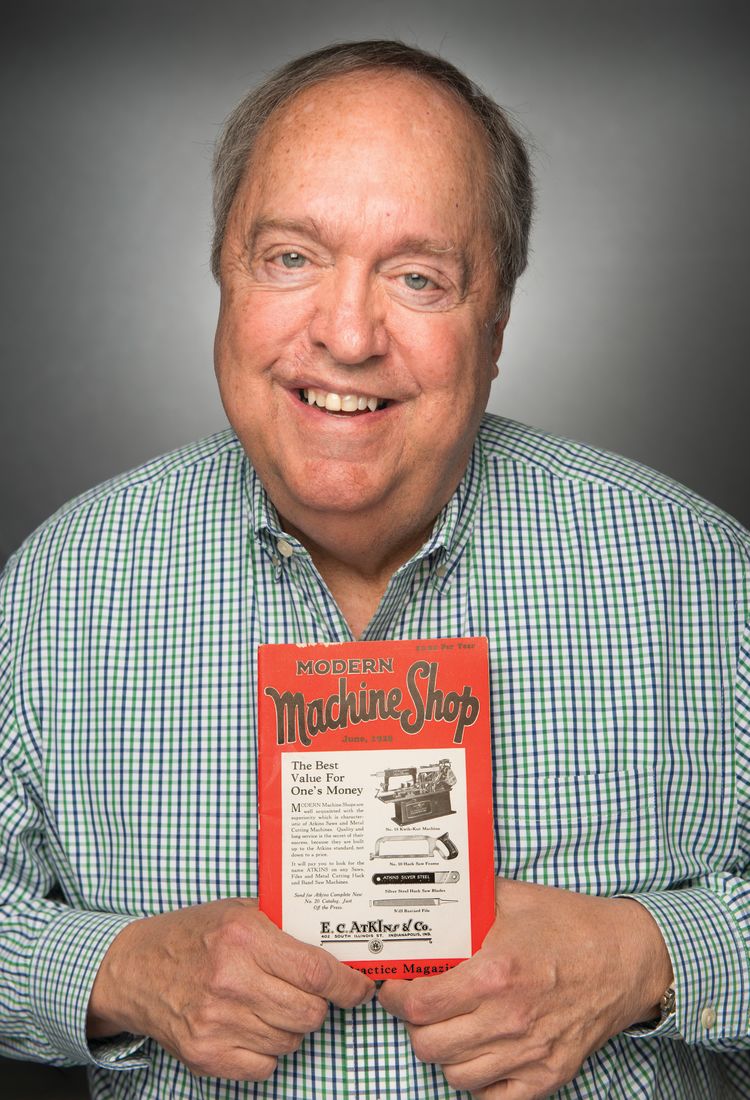
Richard G. Kline with the first issue of Modern Machine Shop
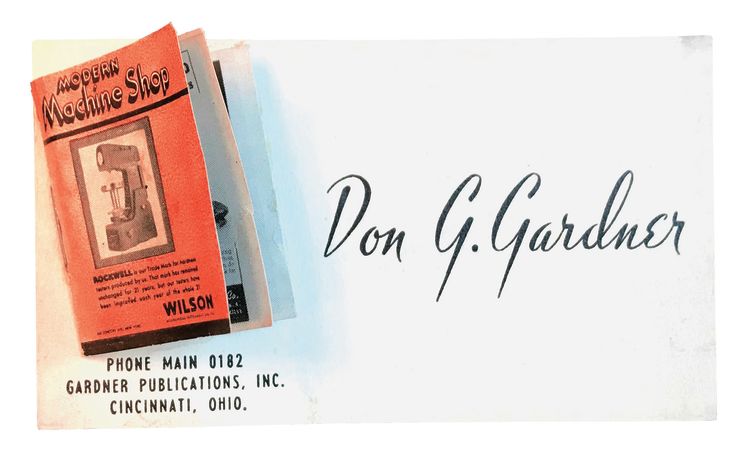
Don Gardner founded Modern Machine Shop magazine in 1928. This is his business card, which featured a small, 3D magazine.
